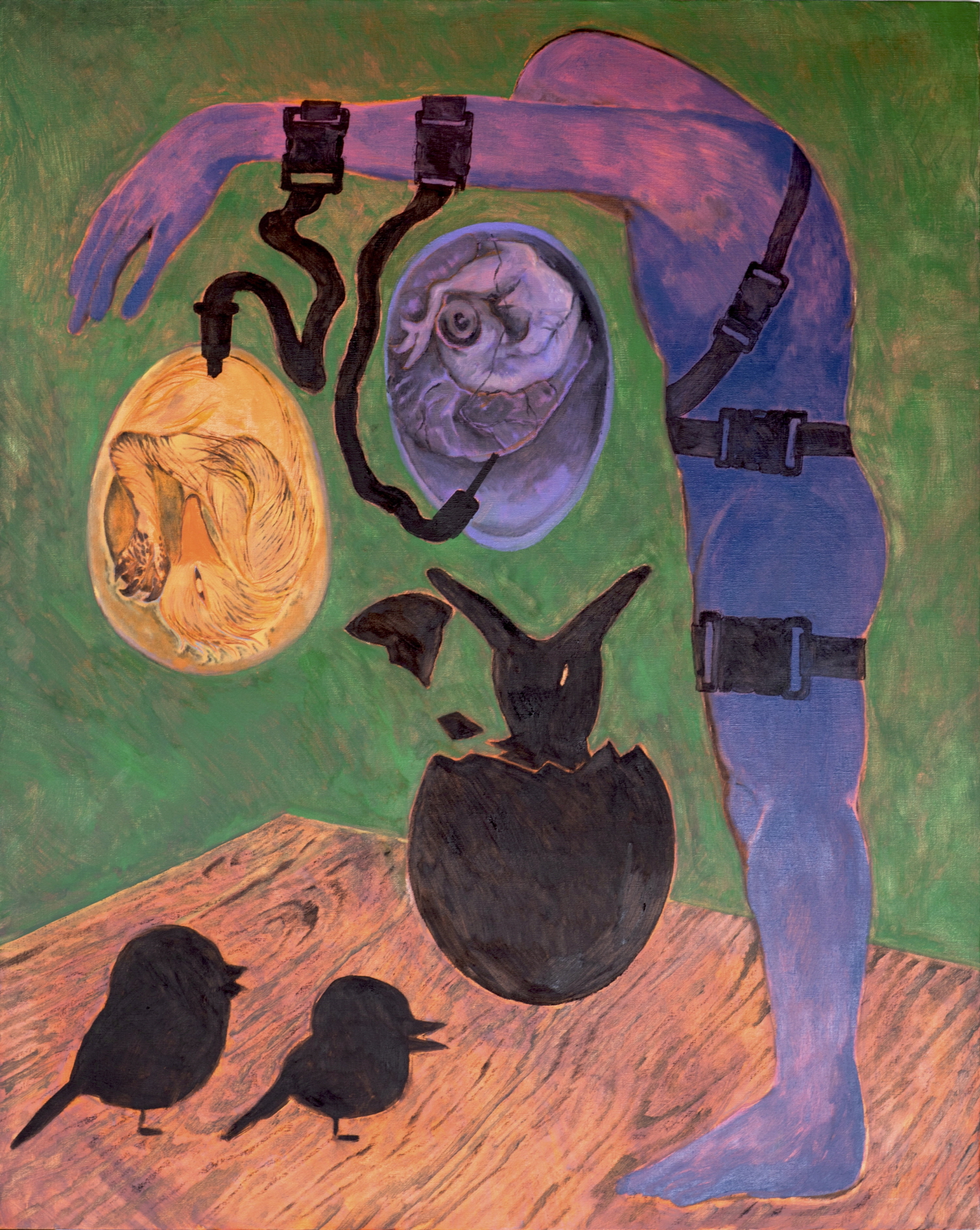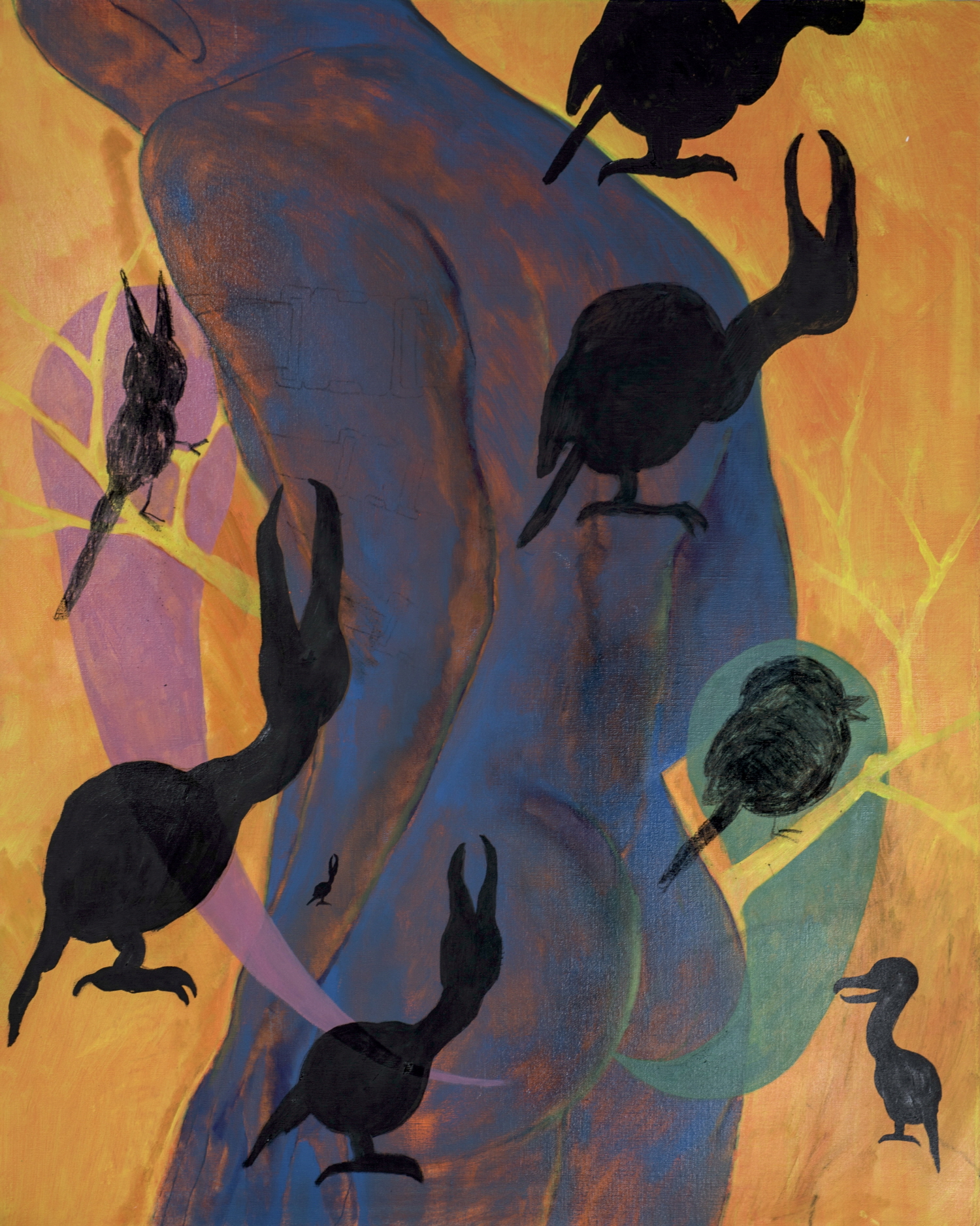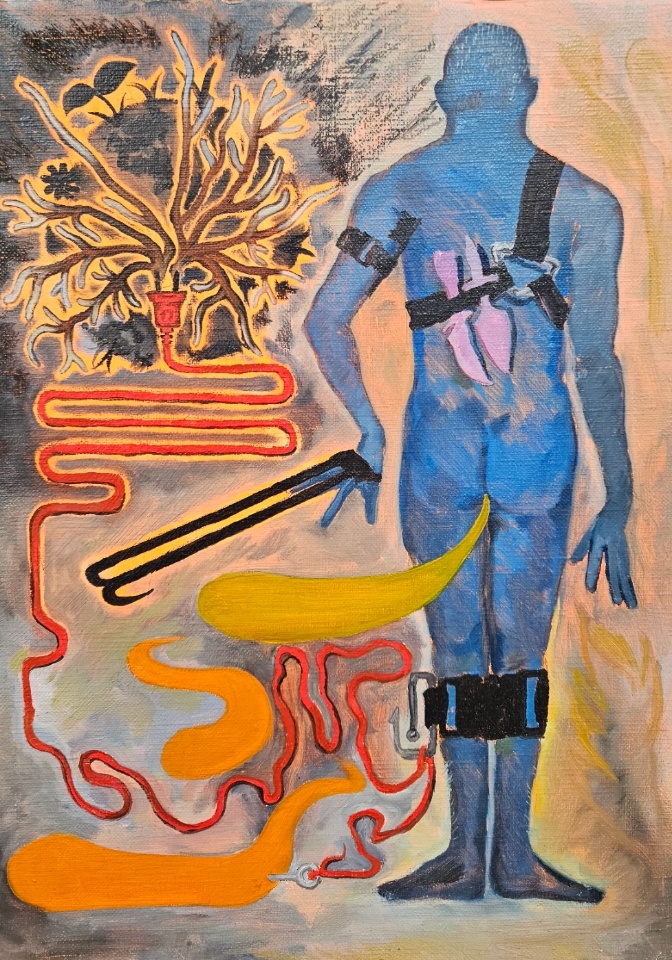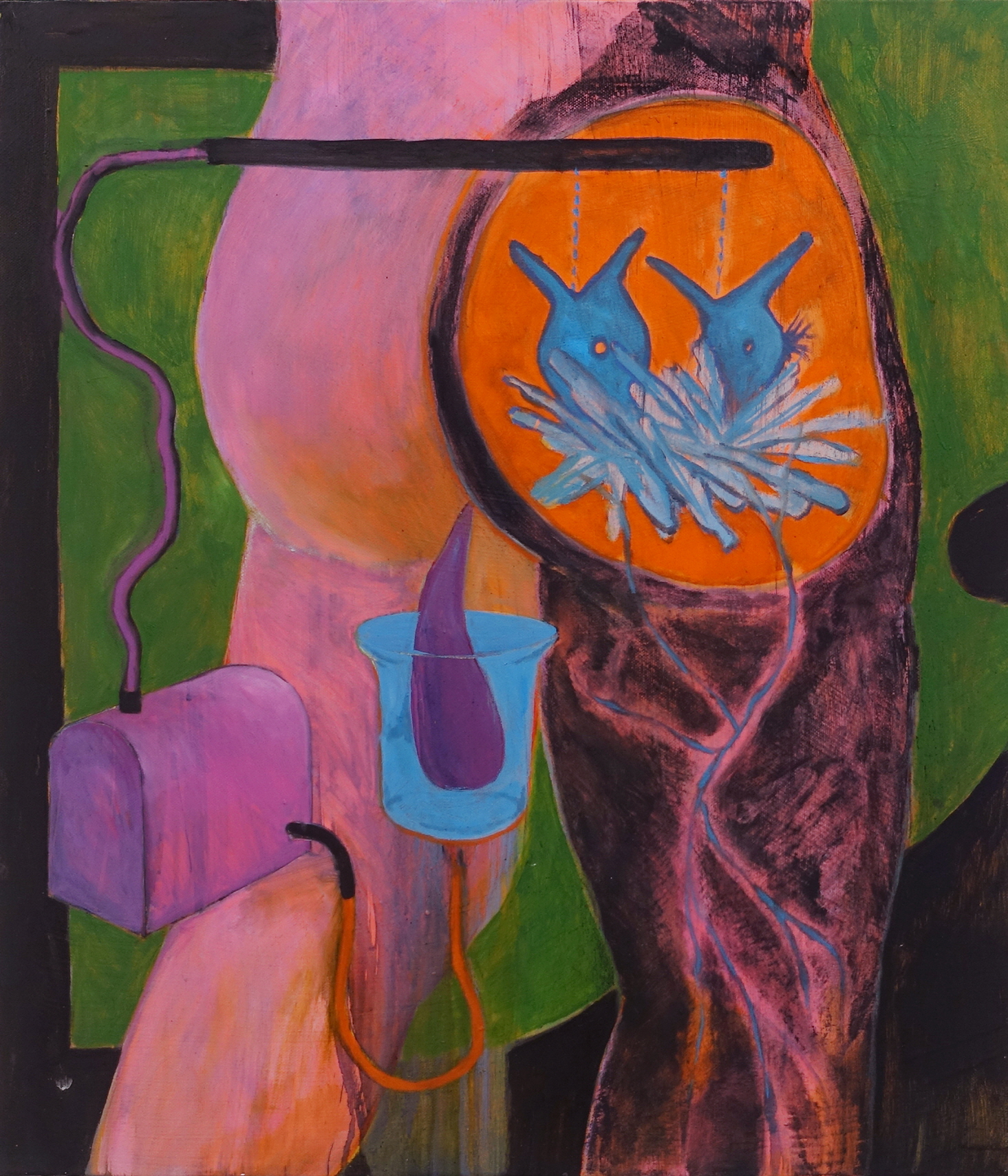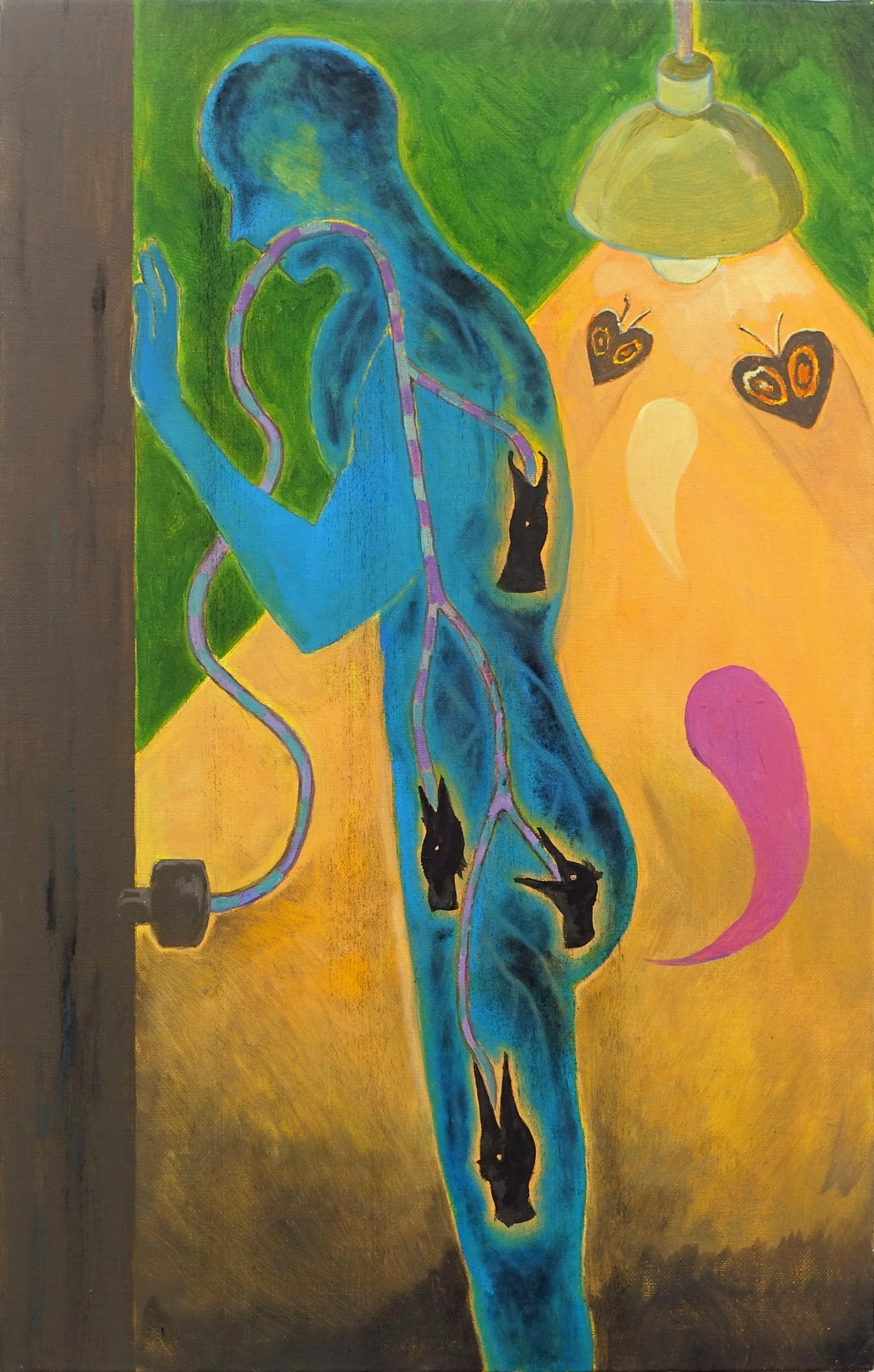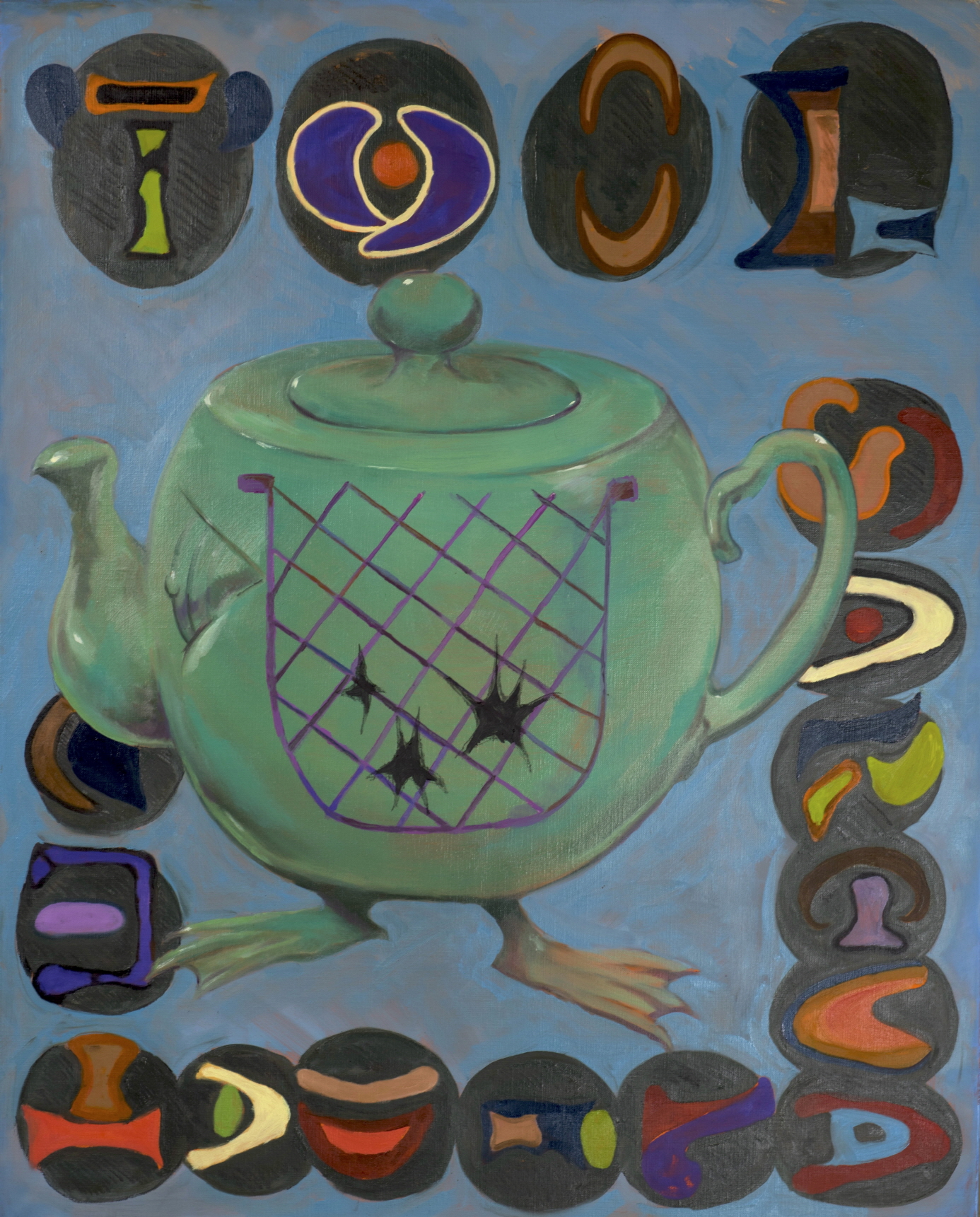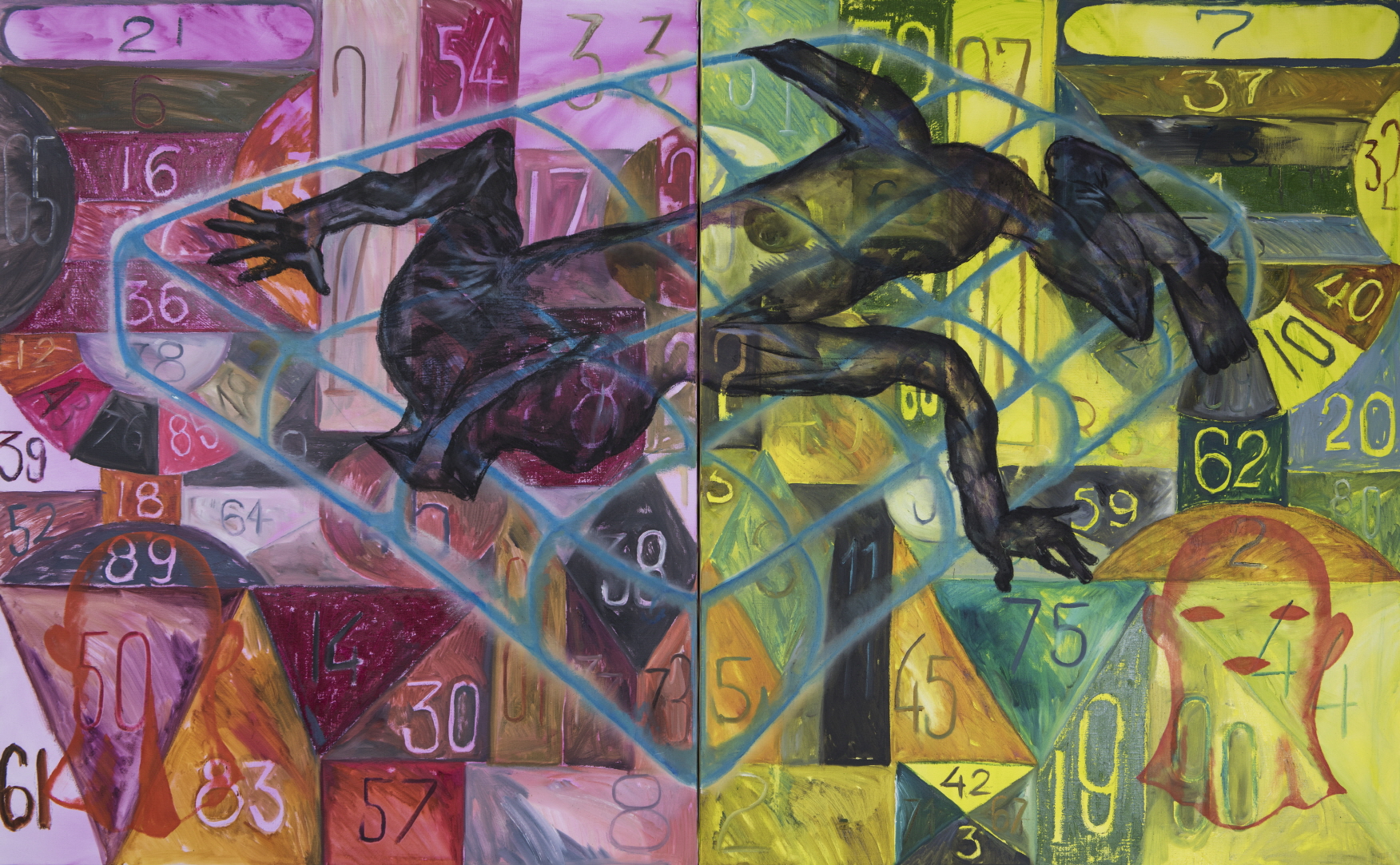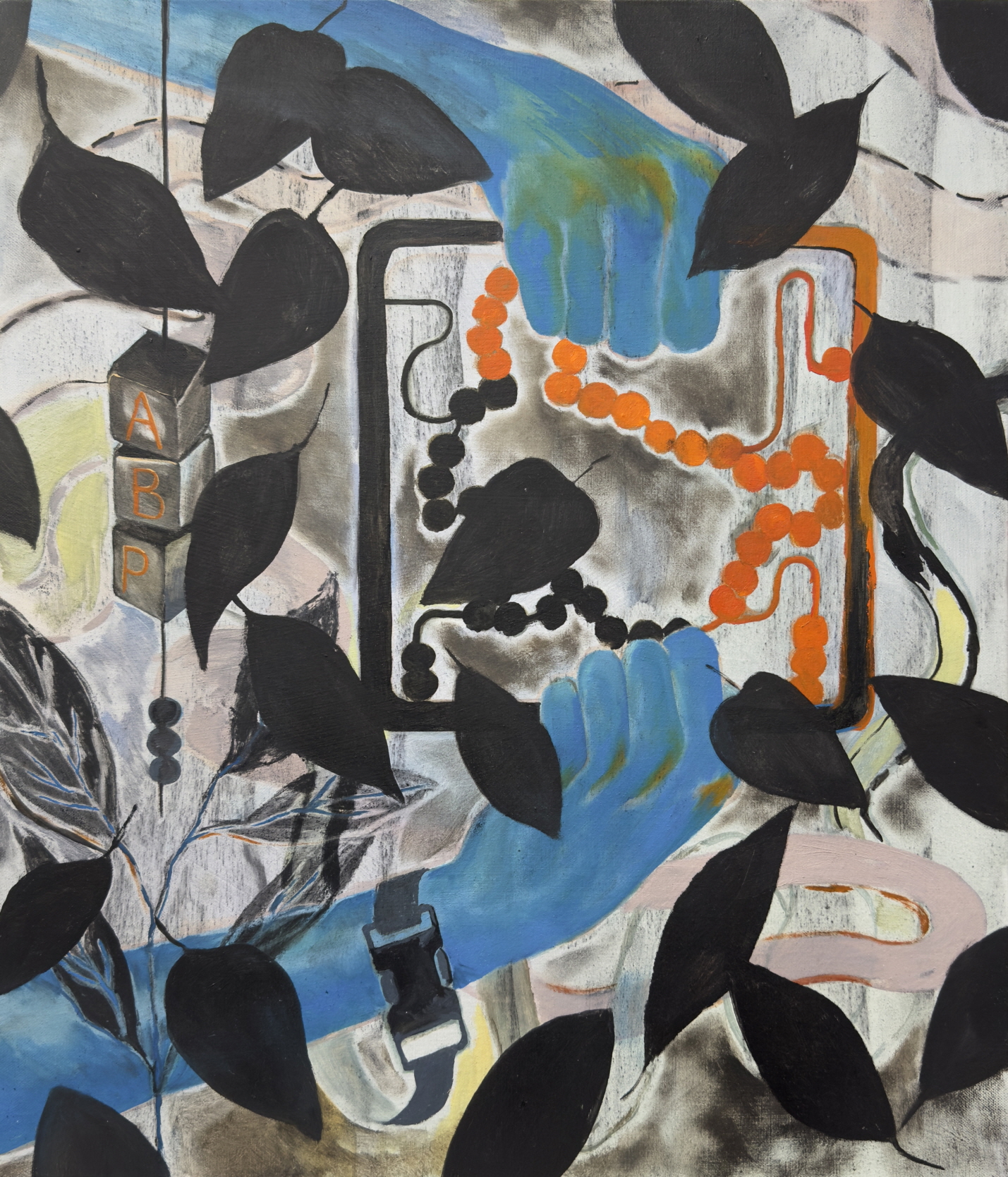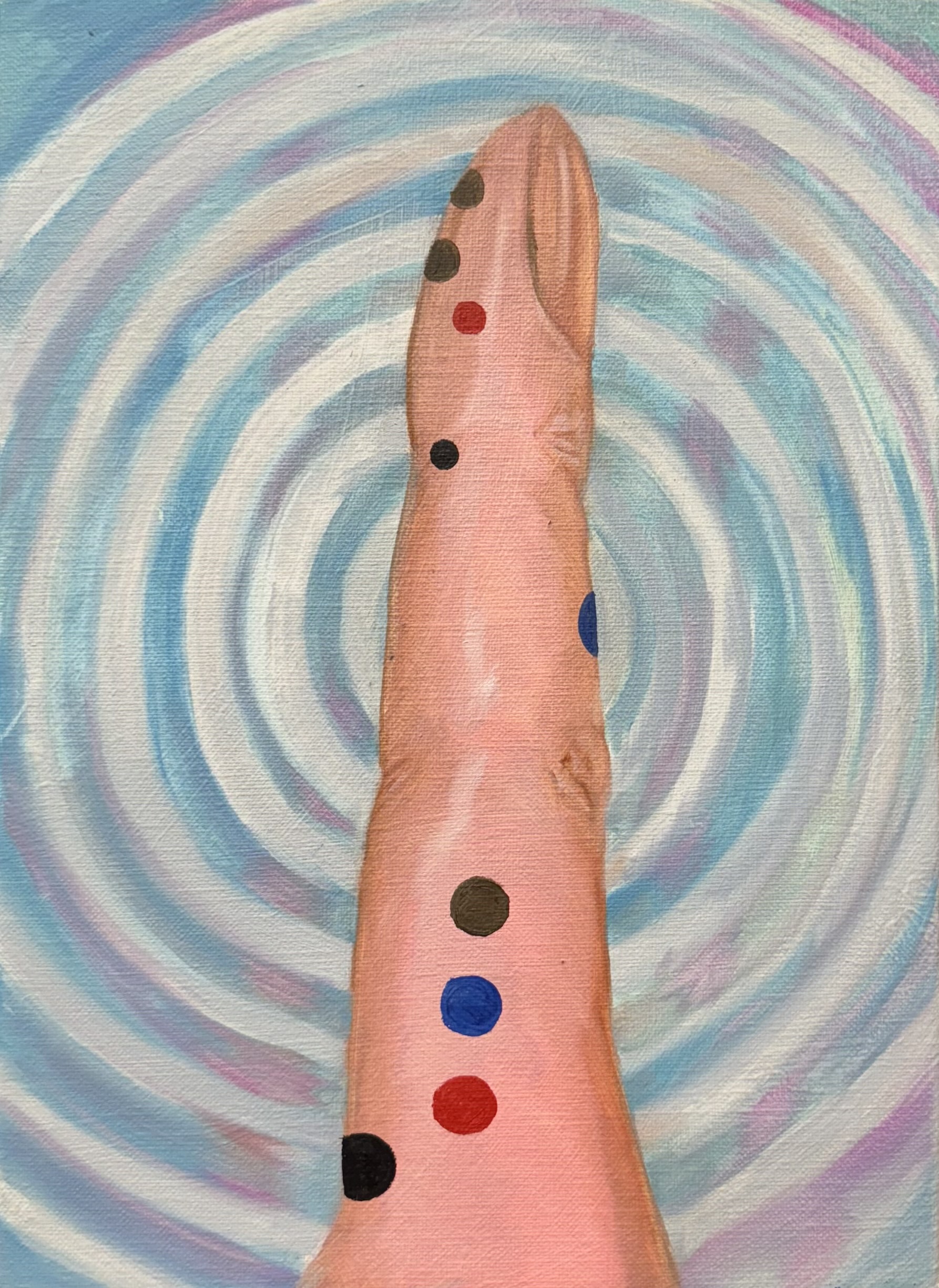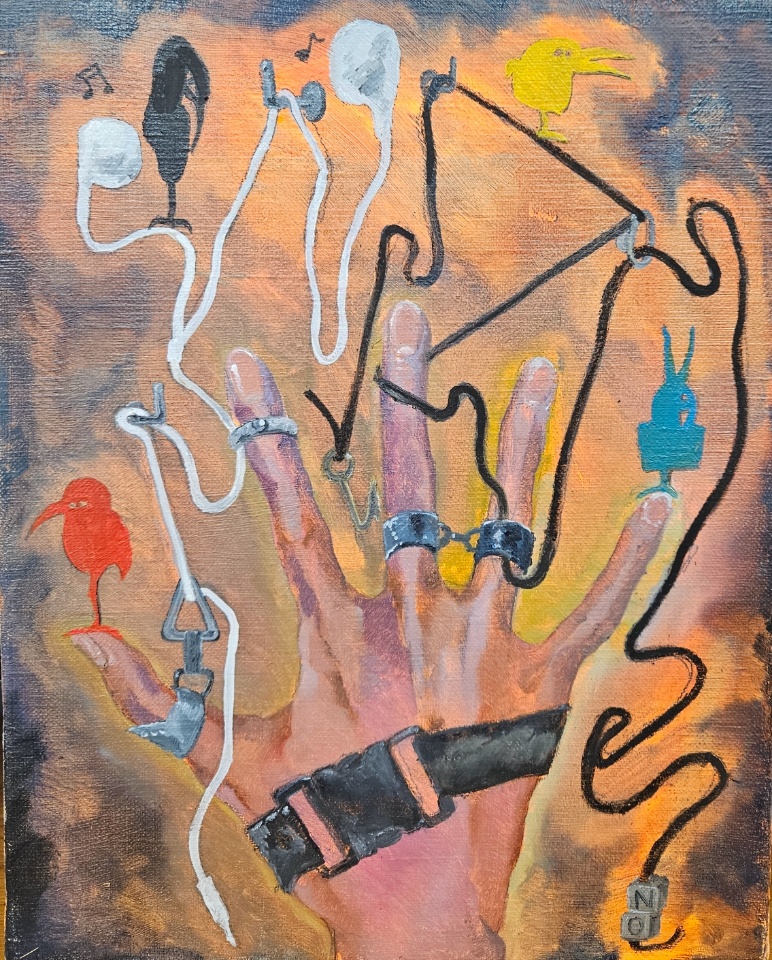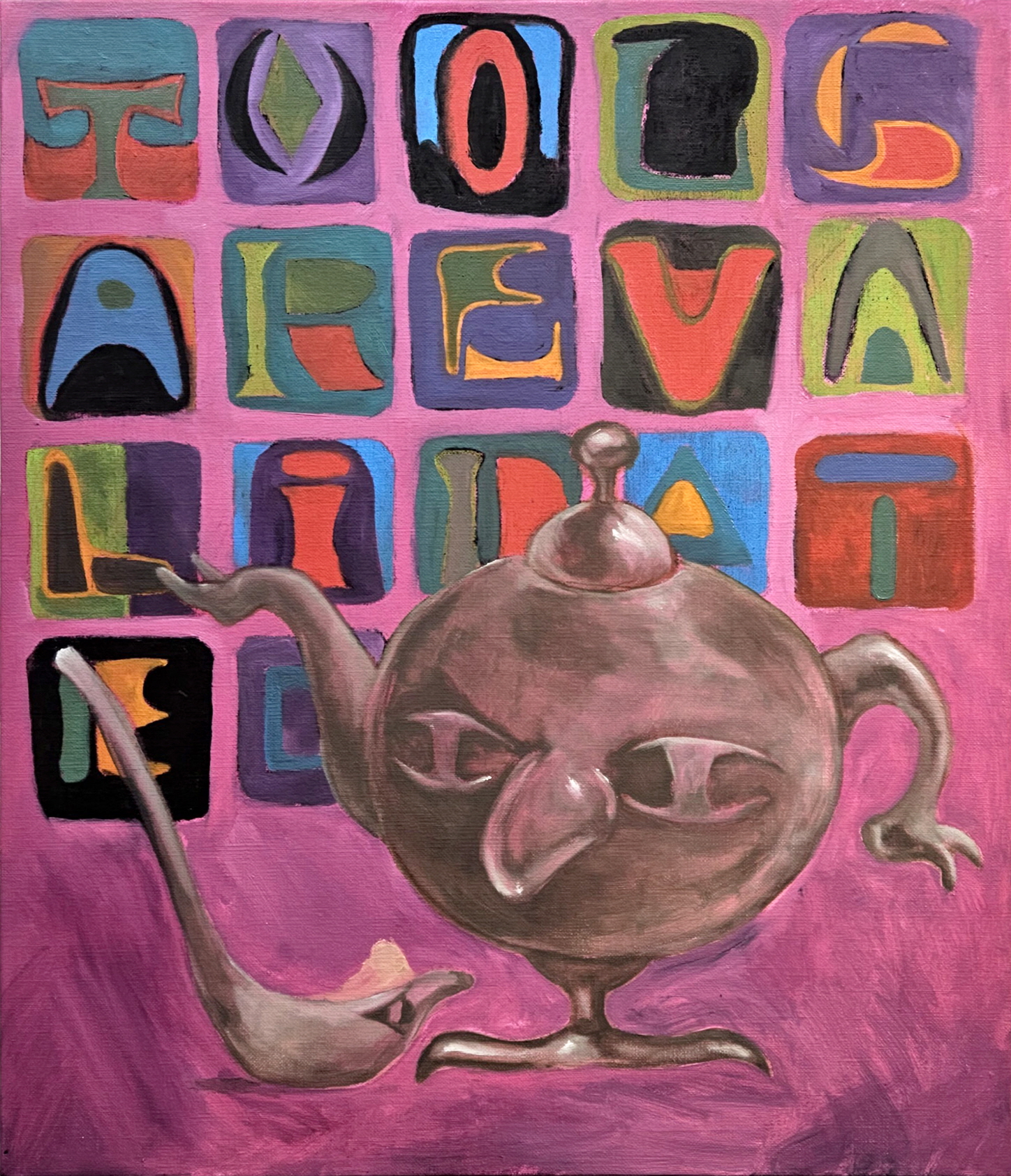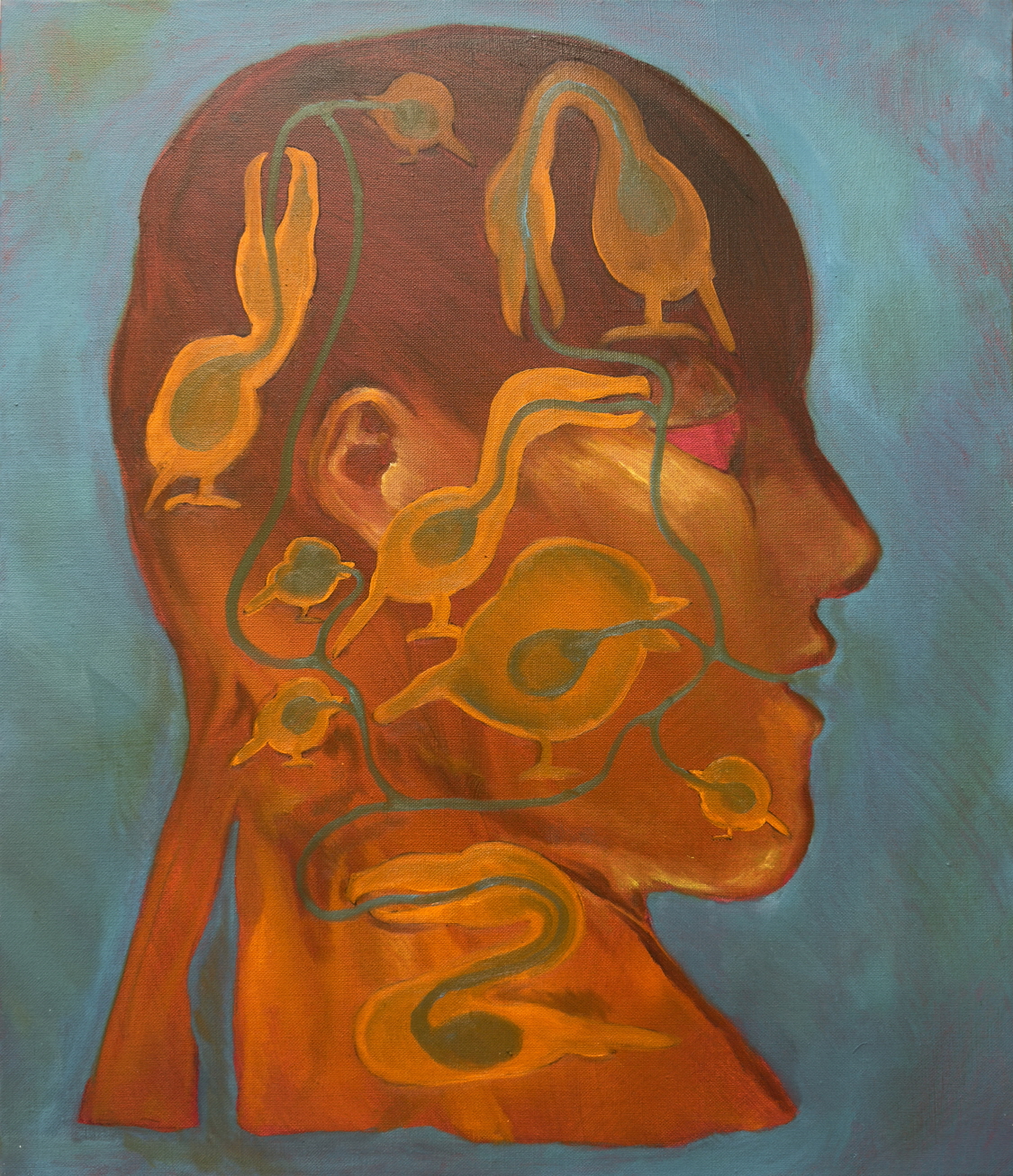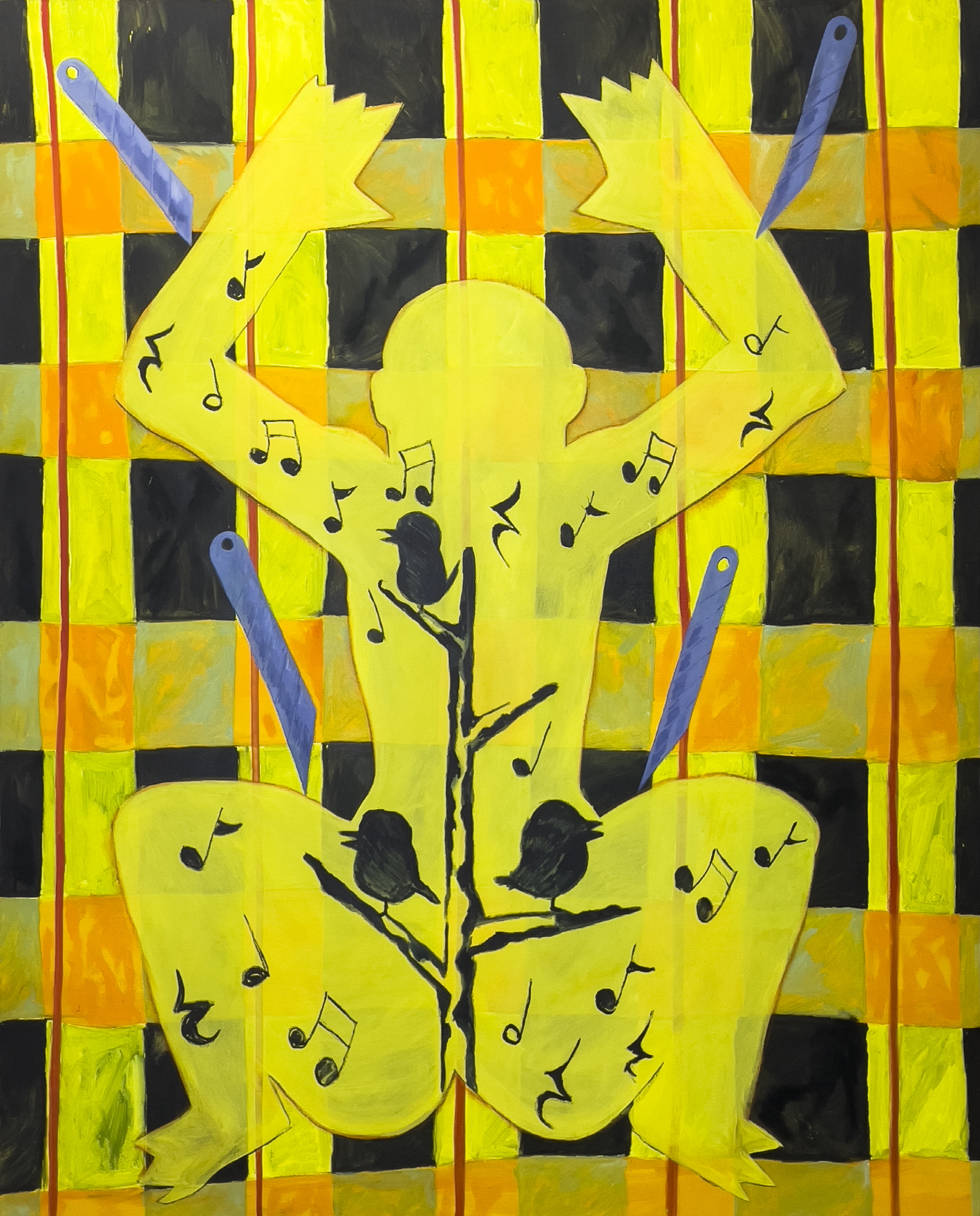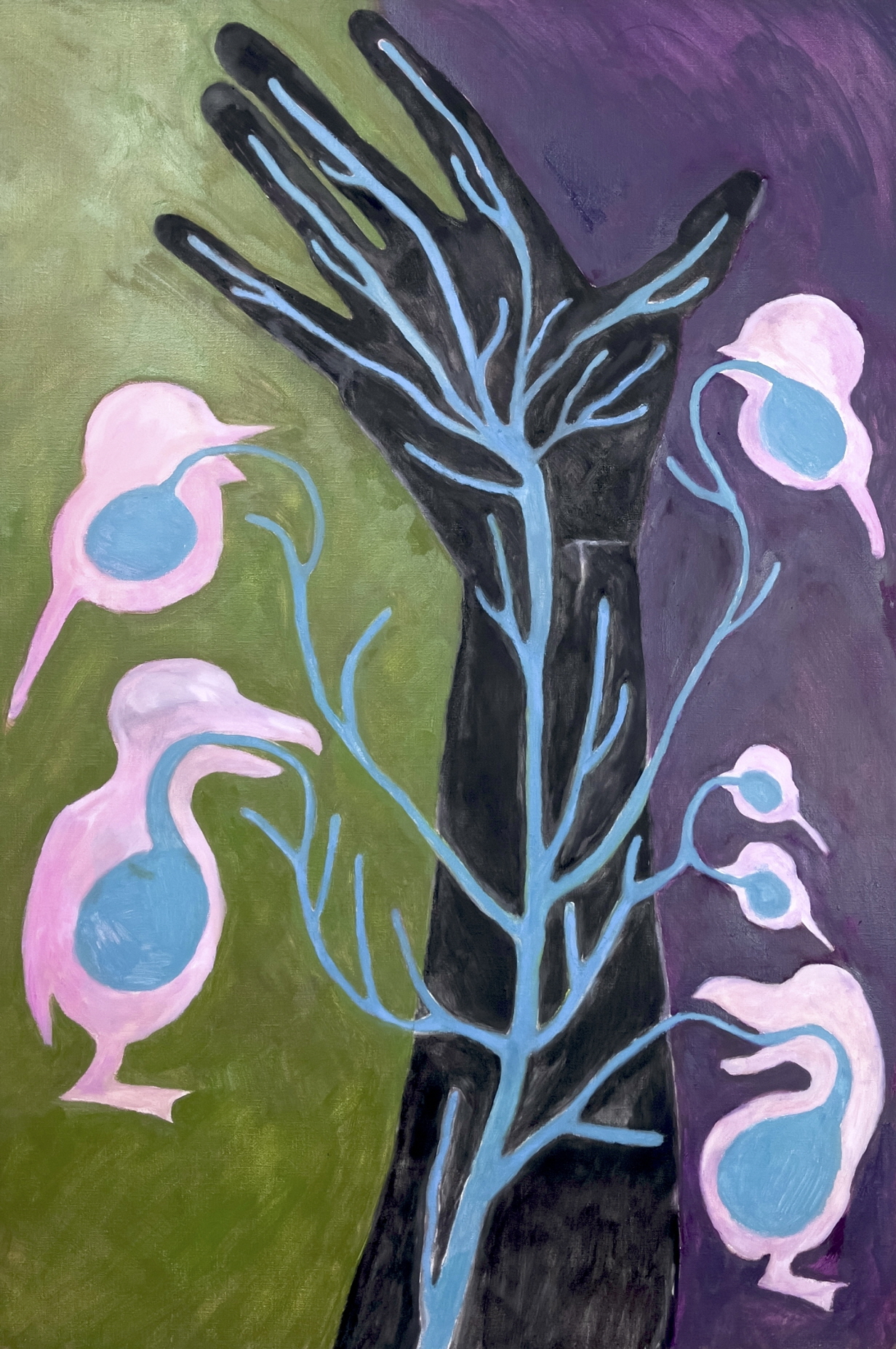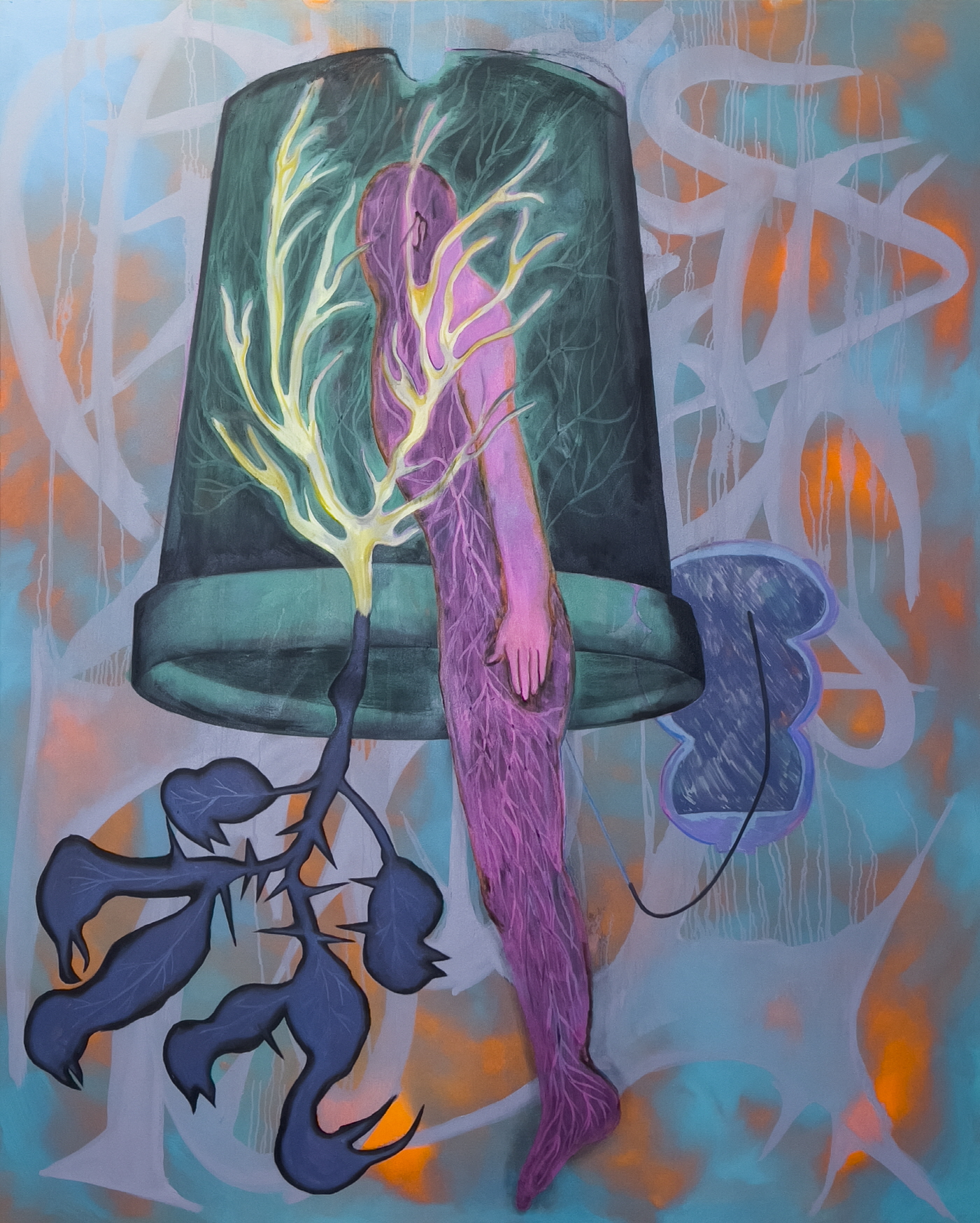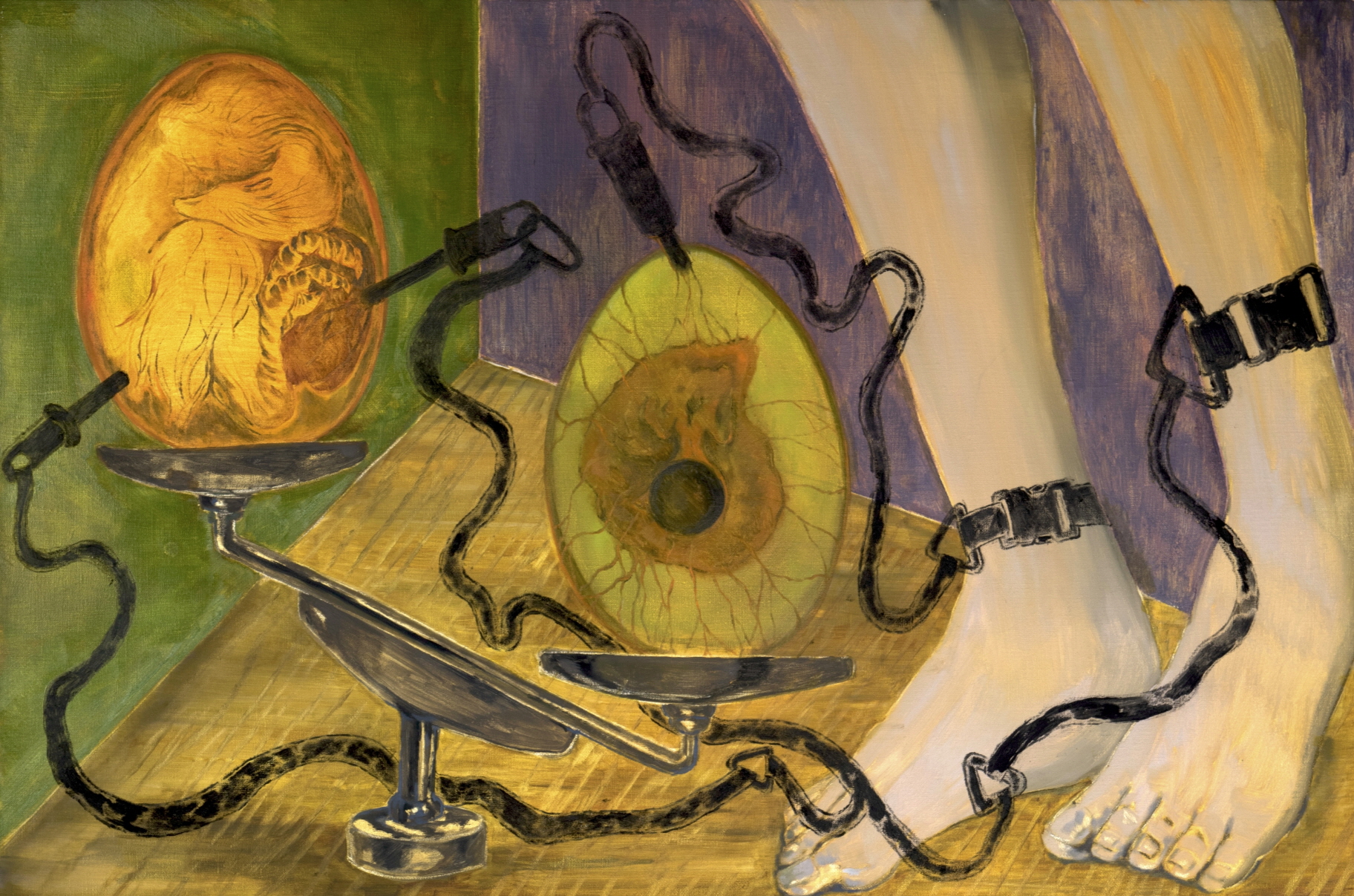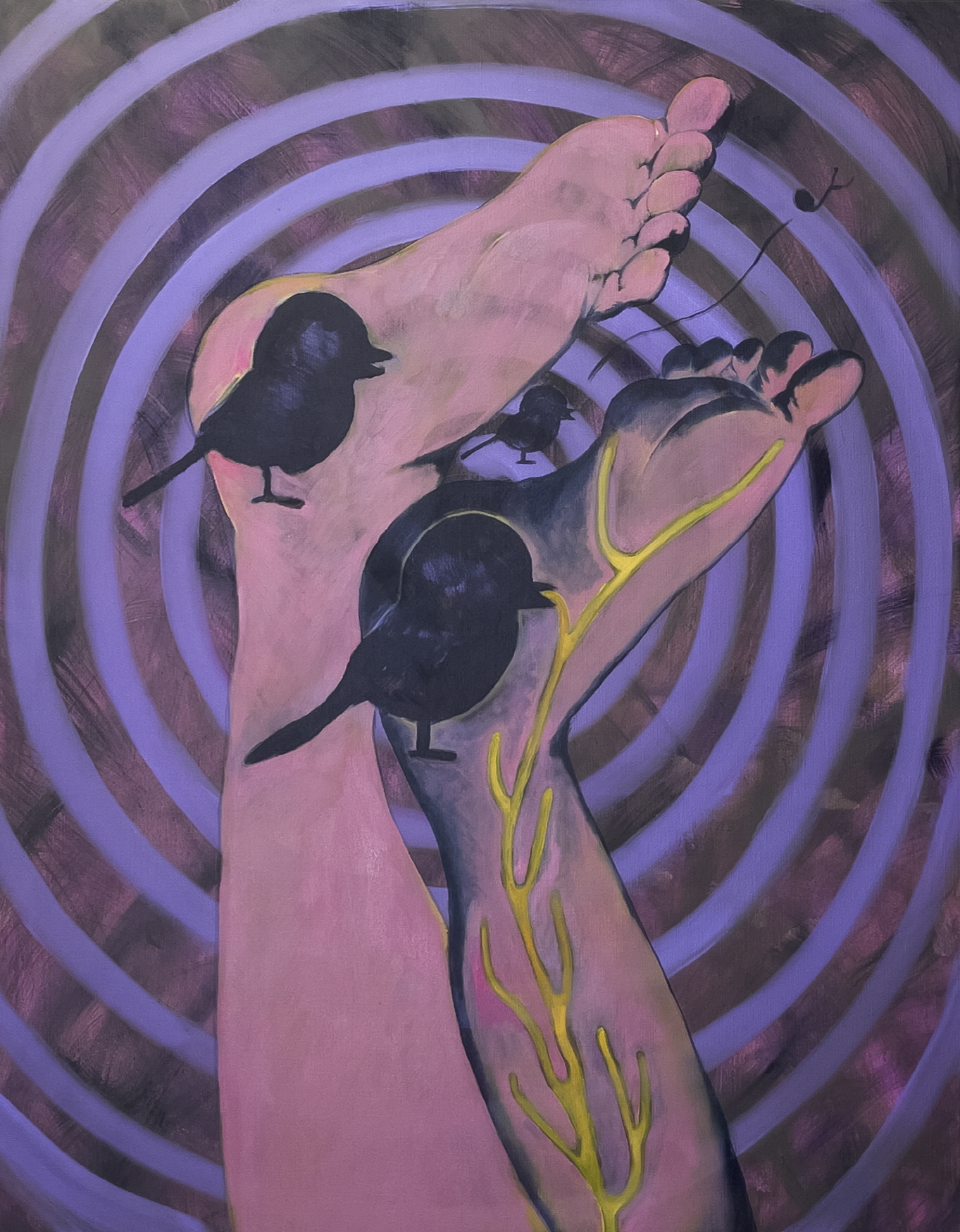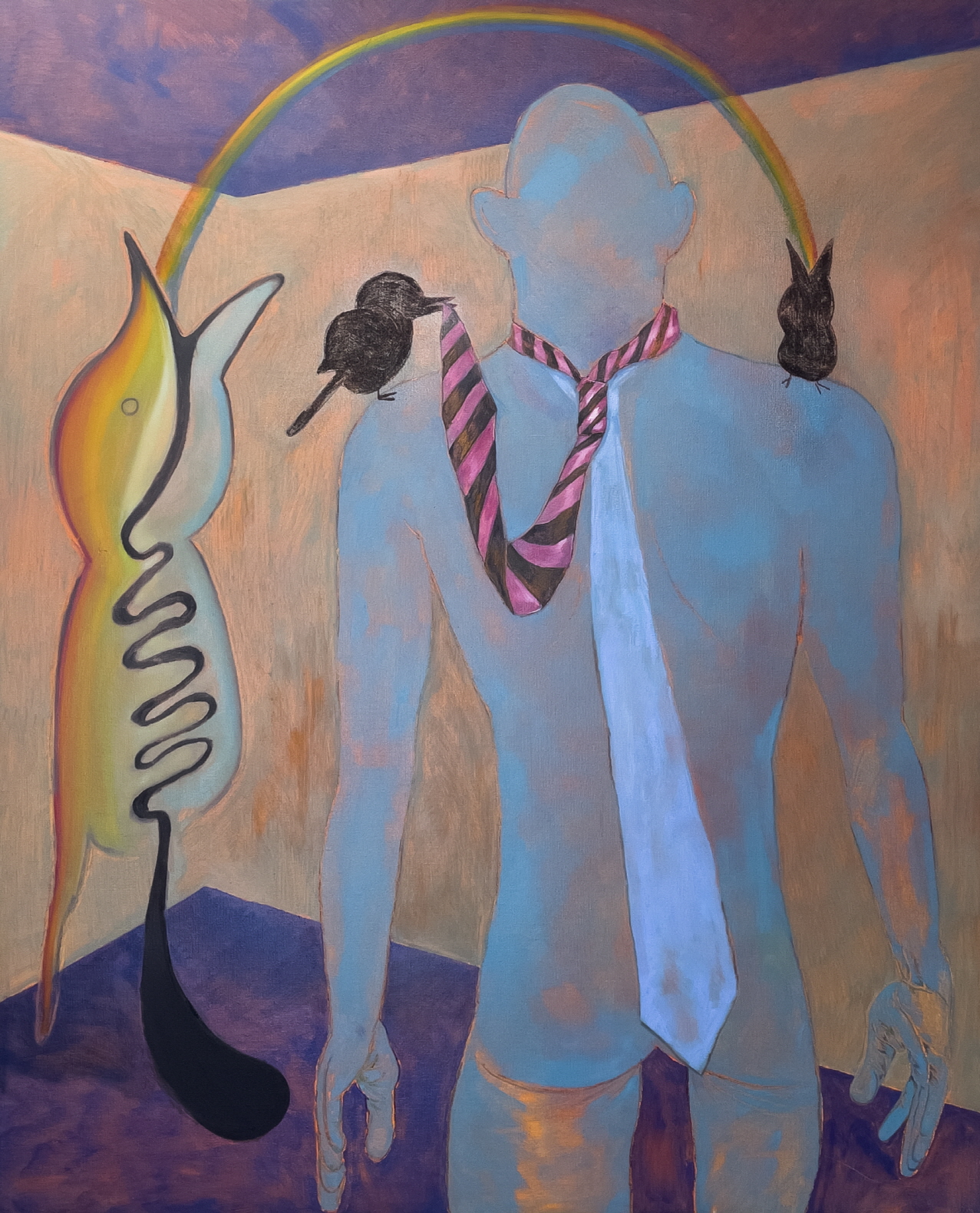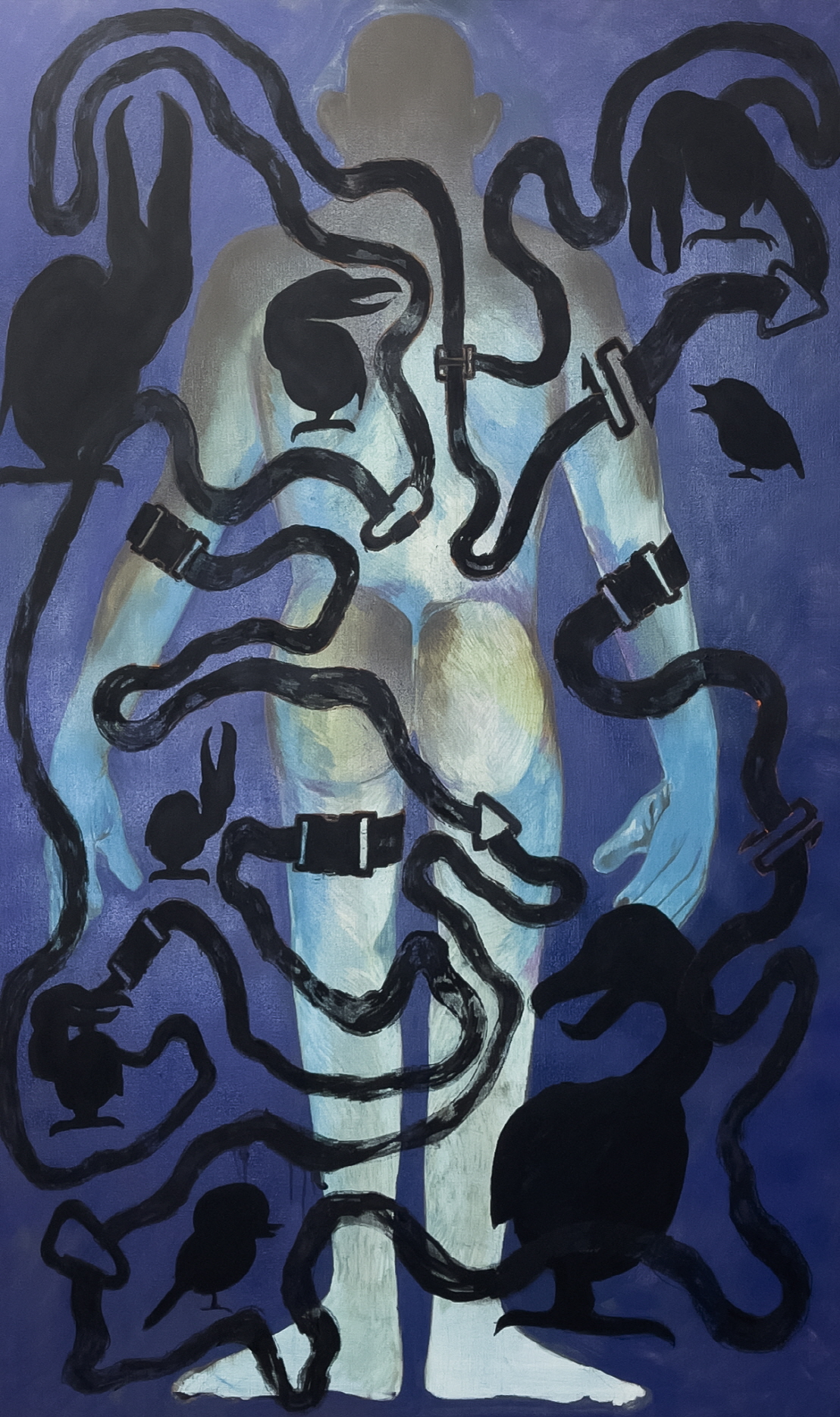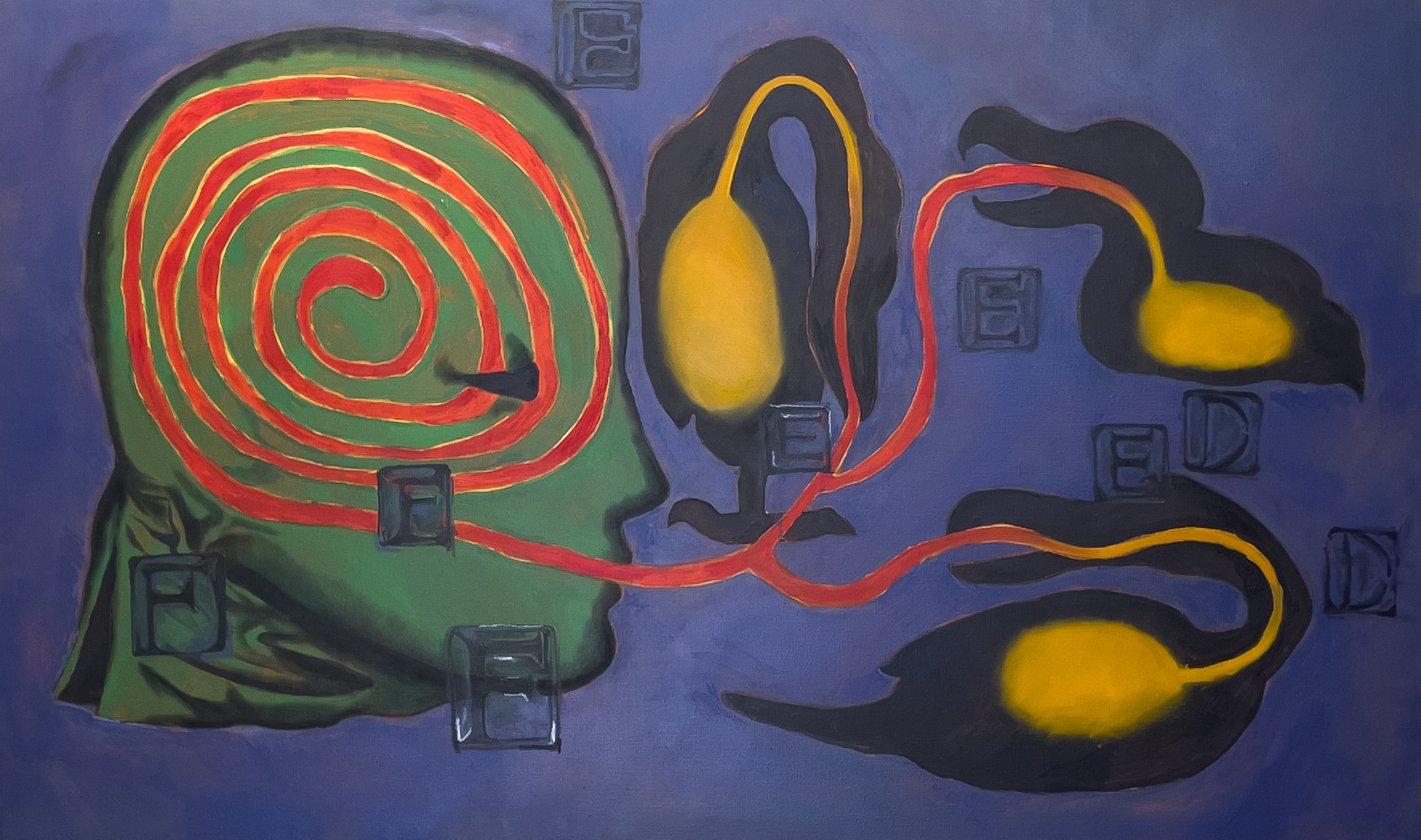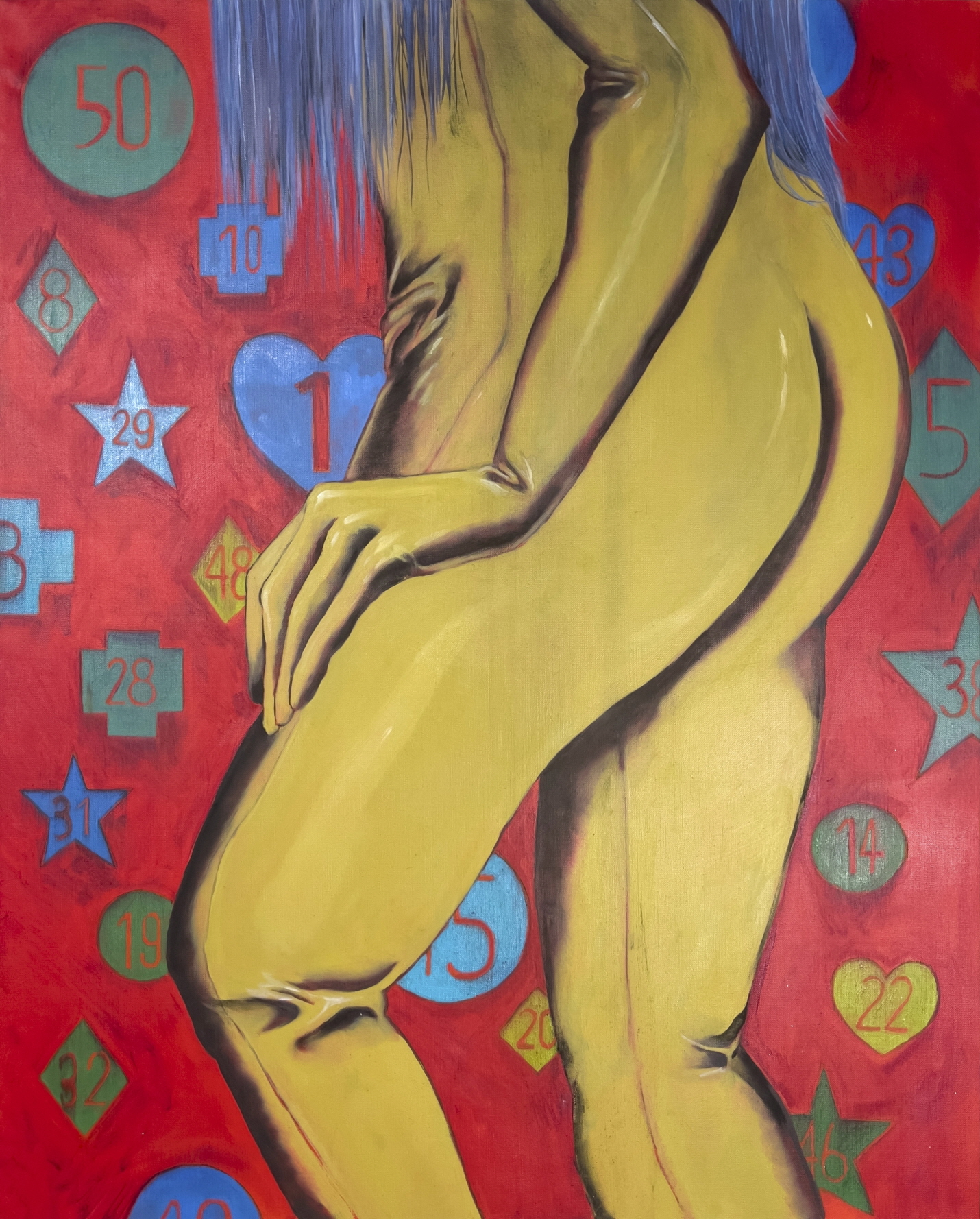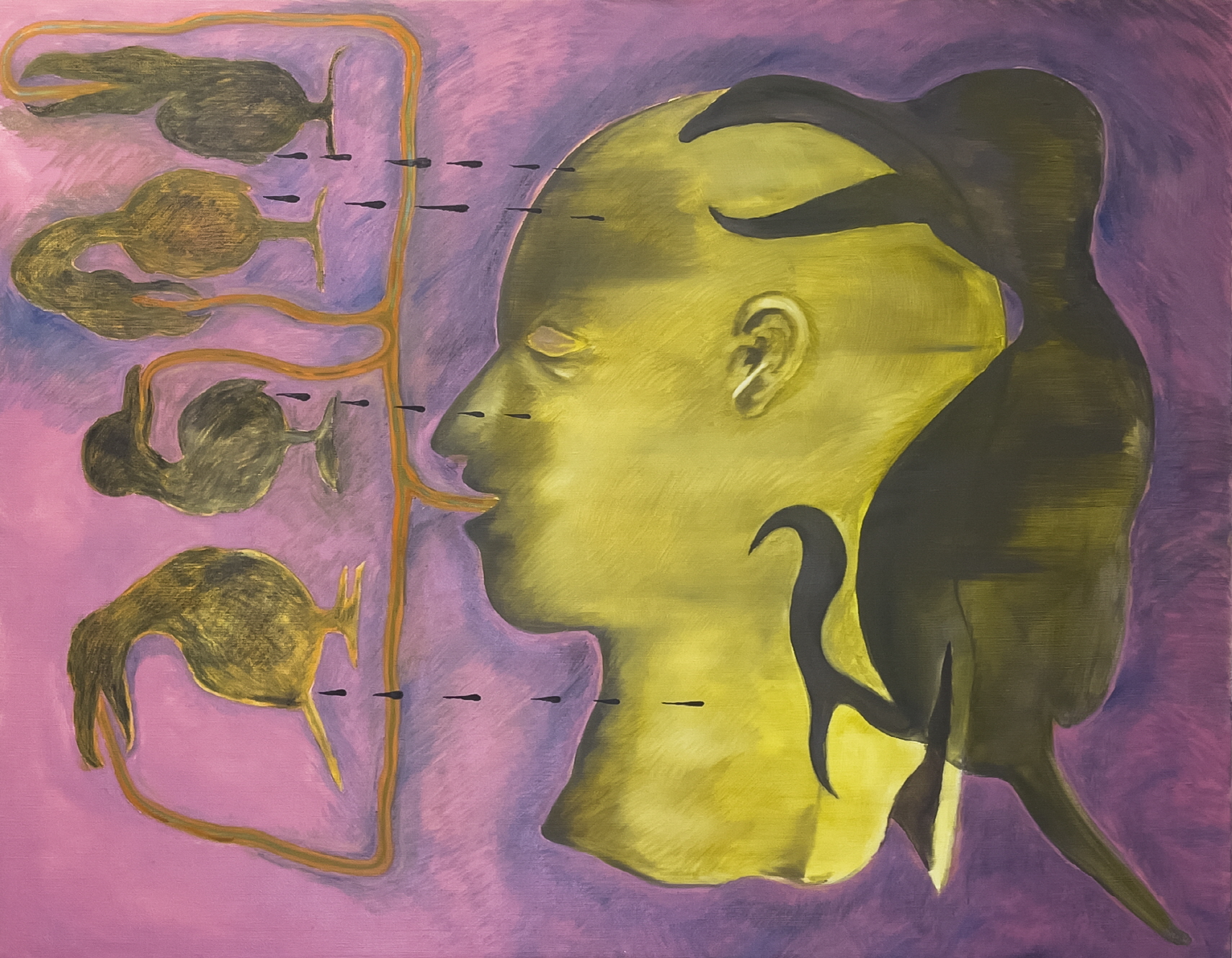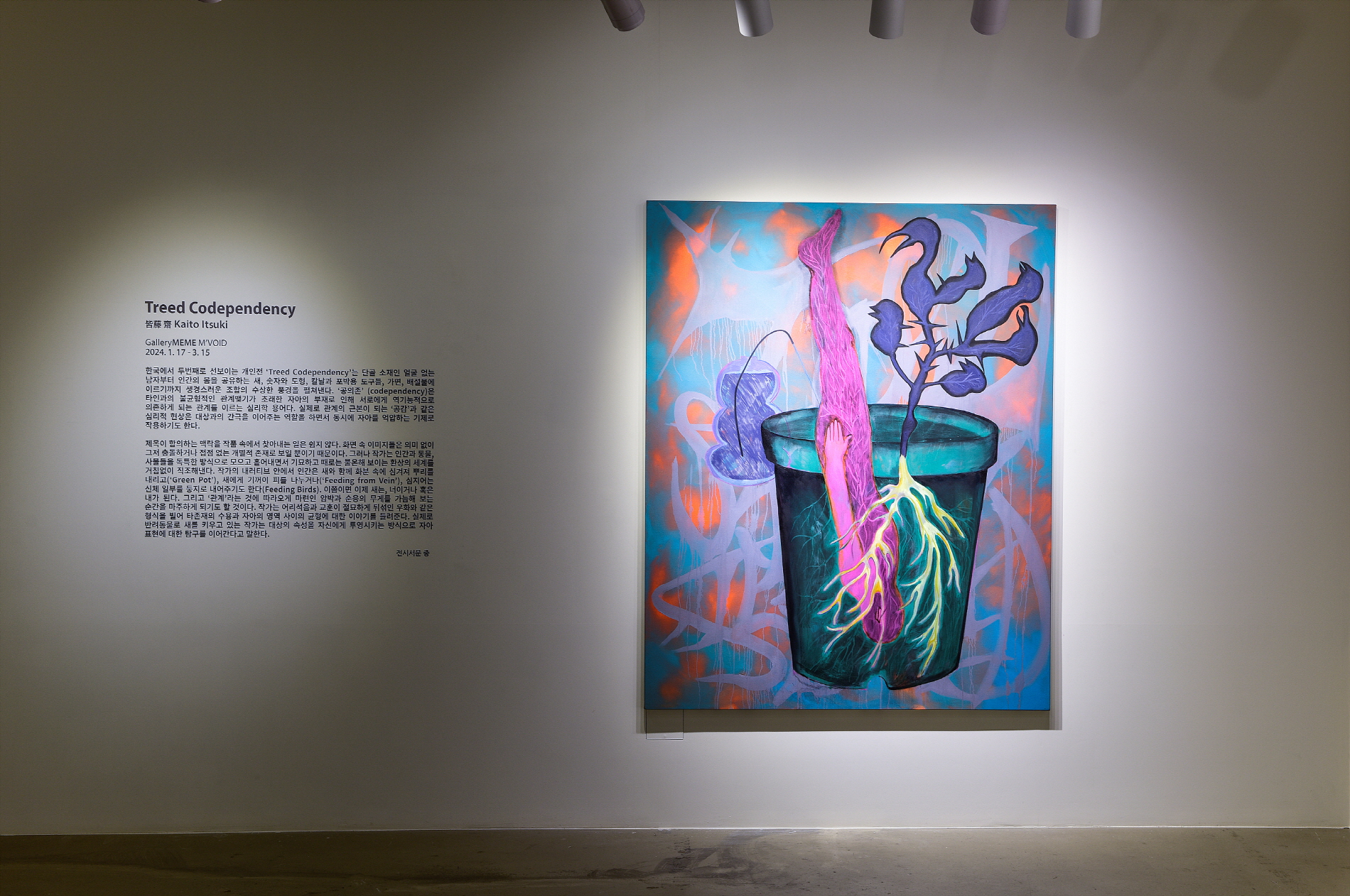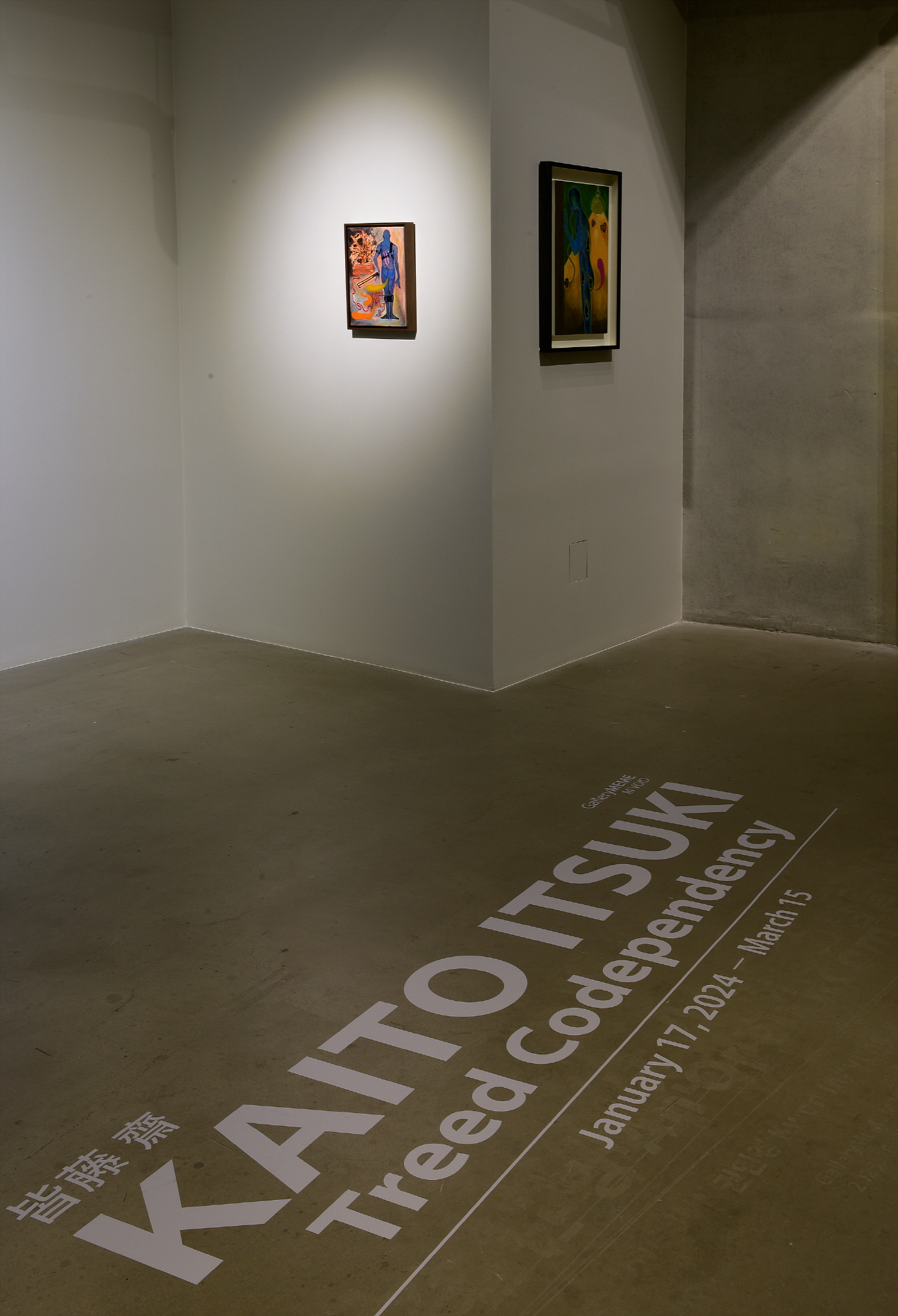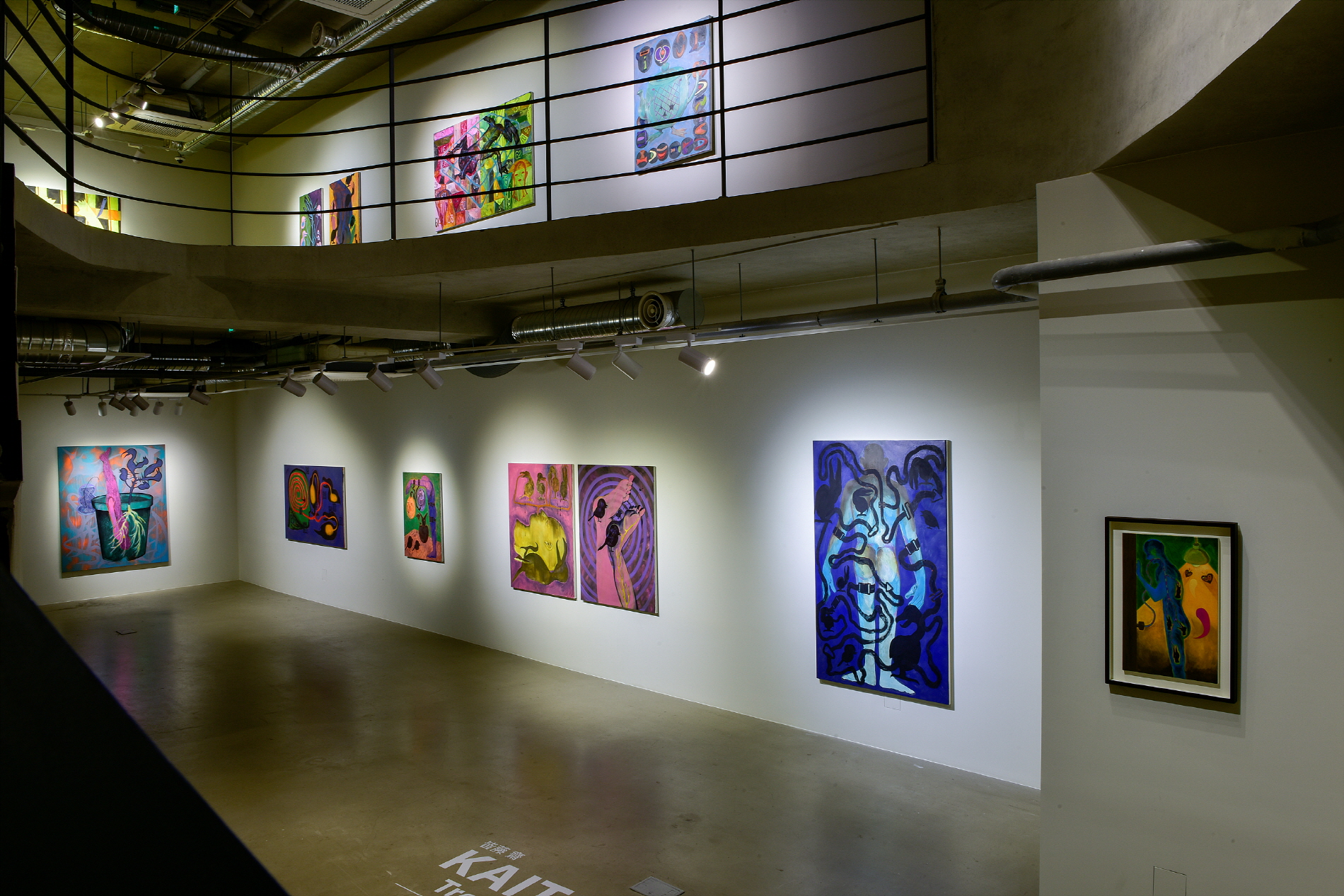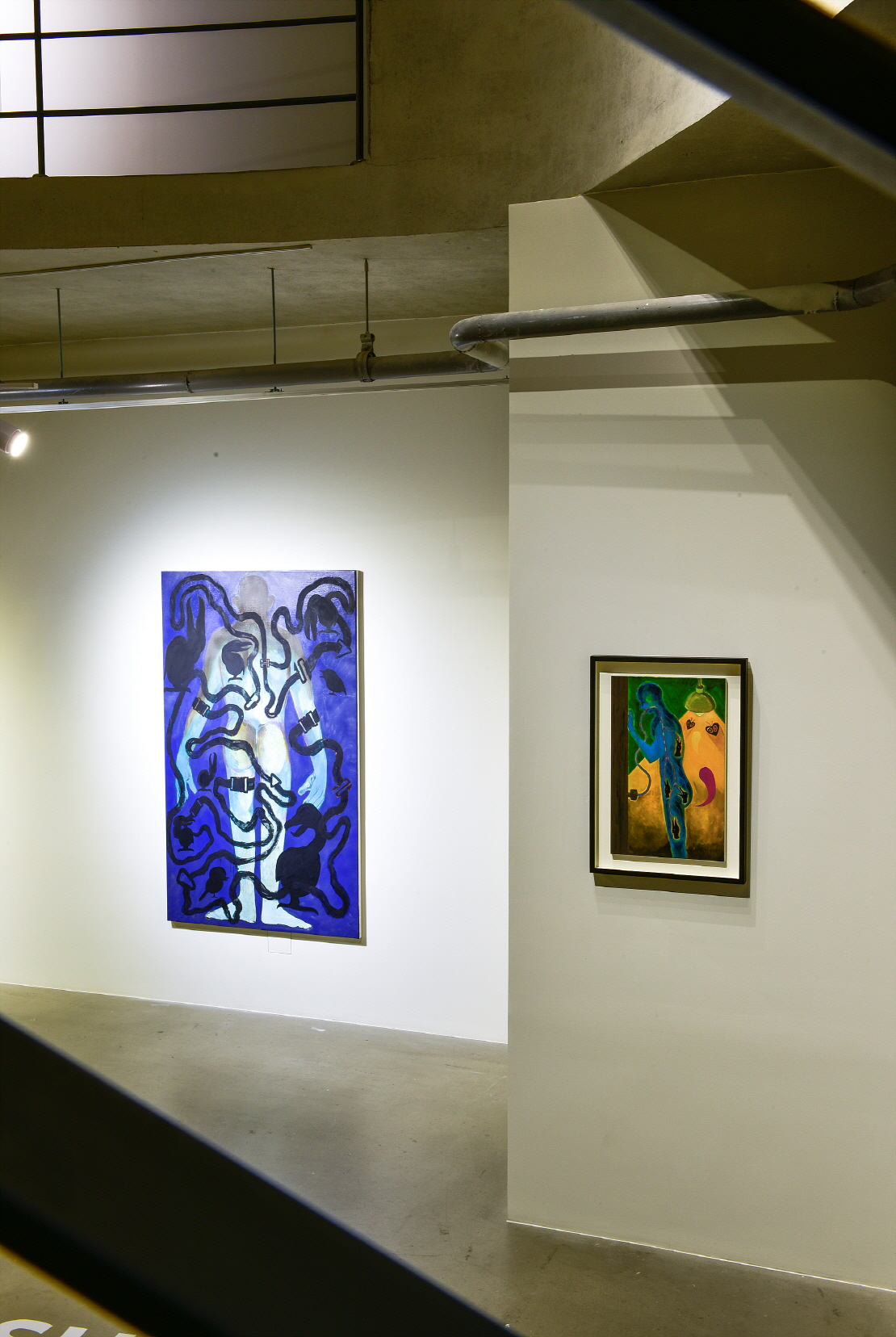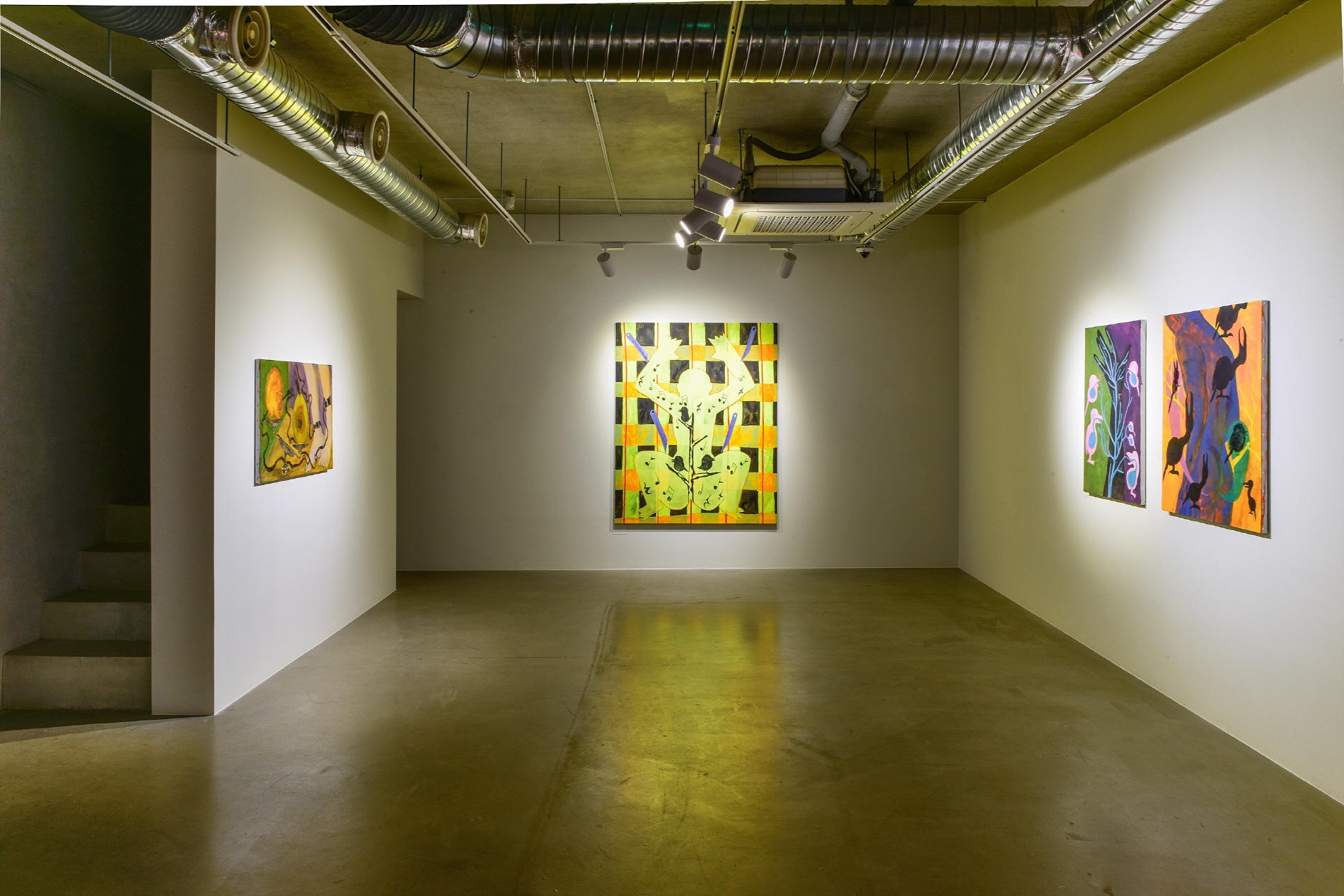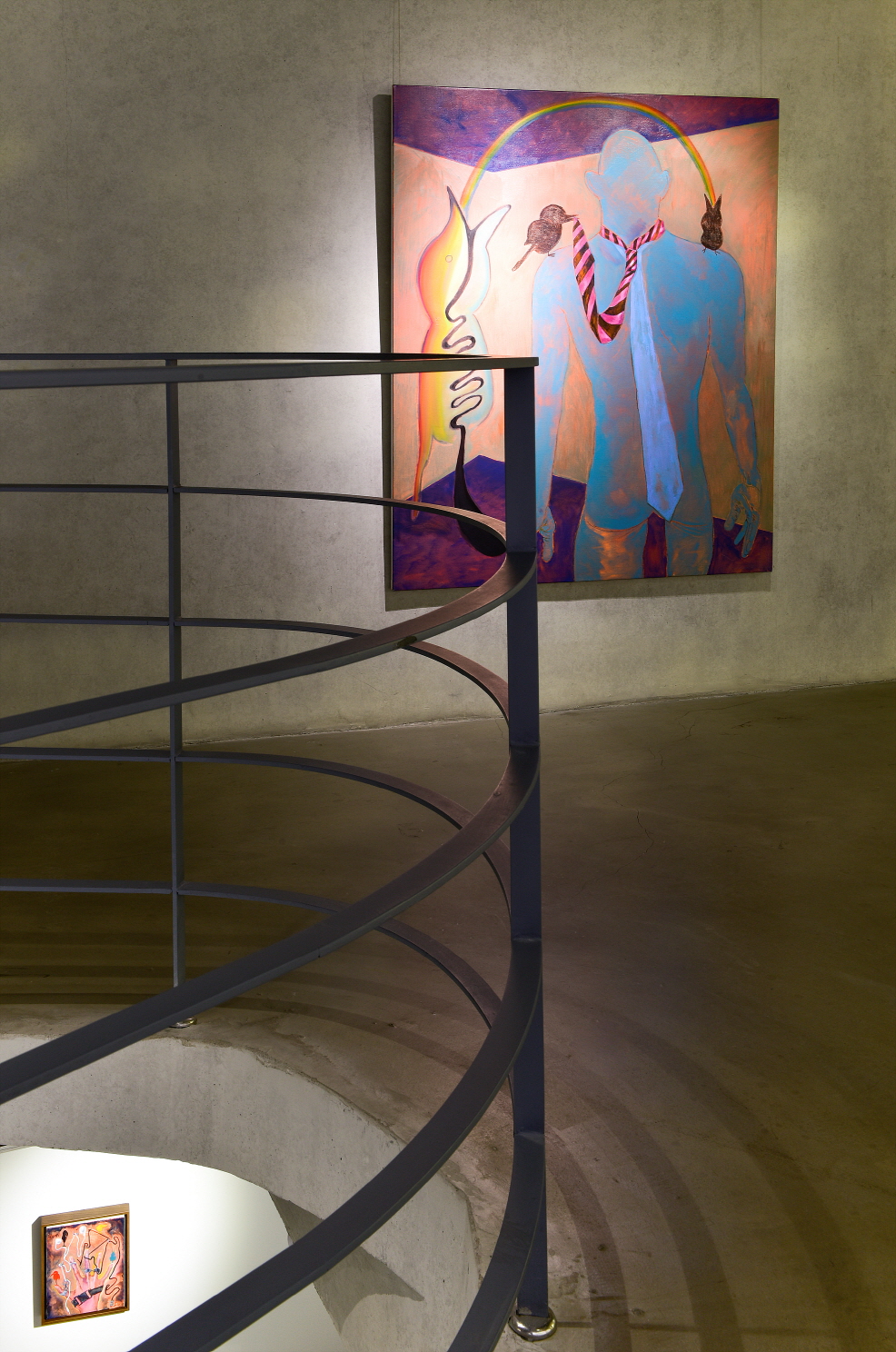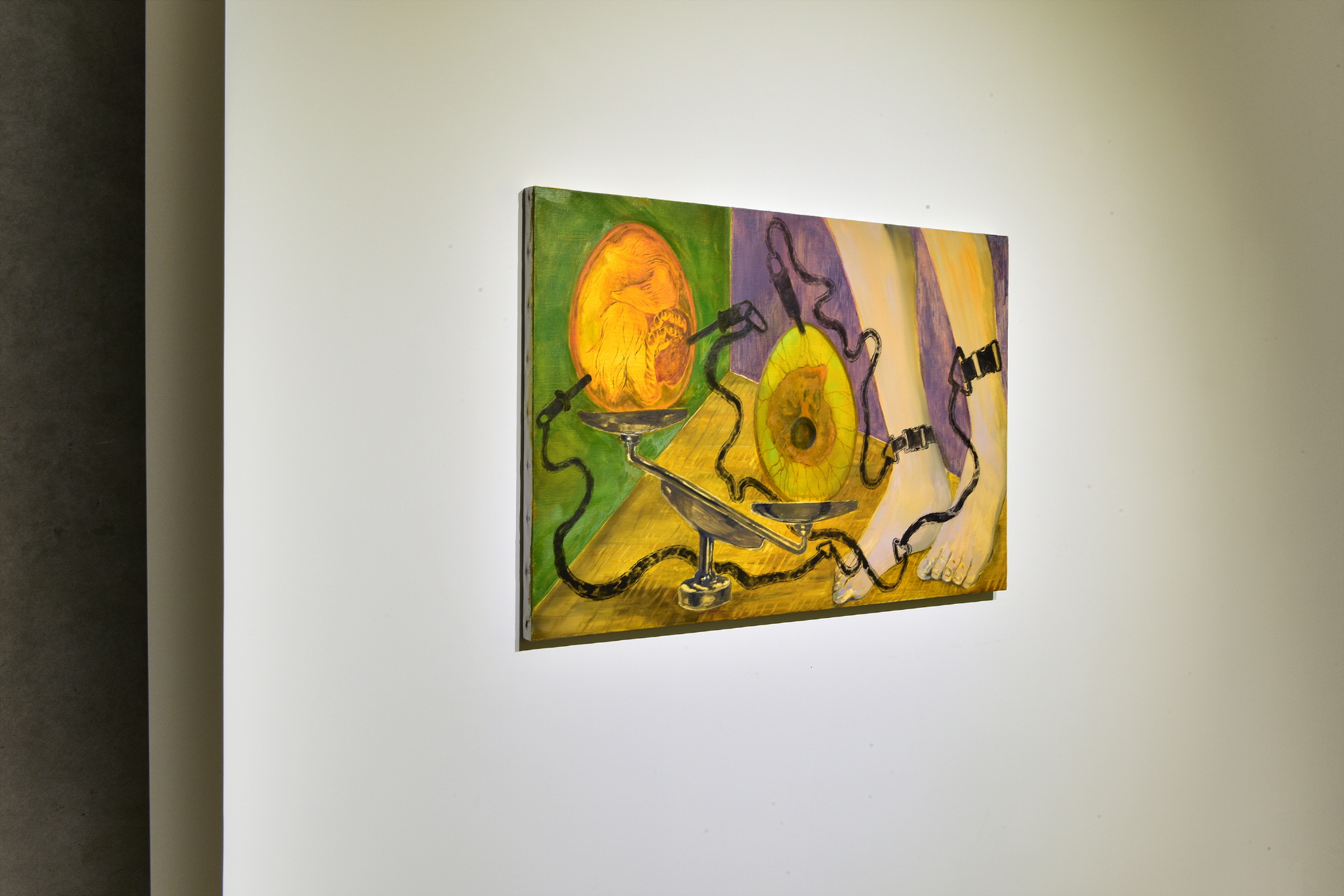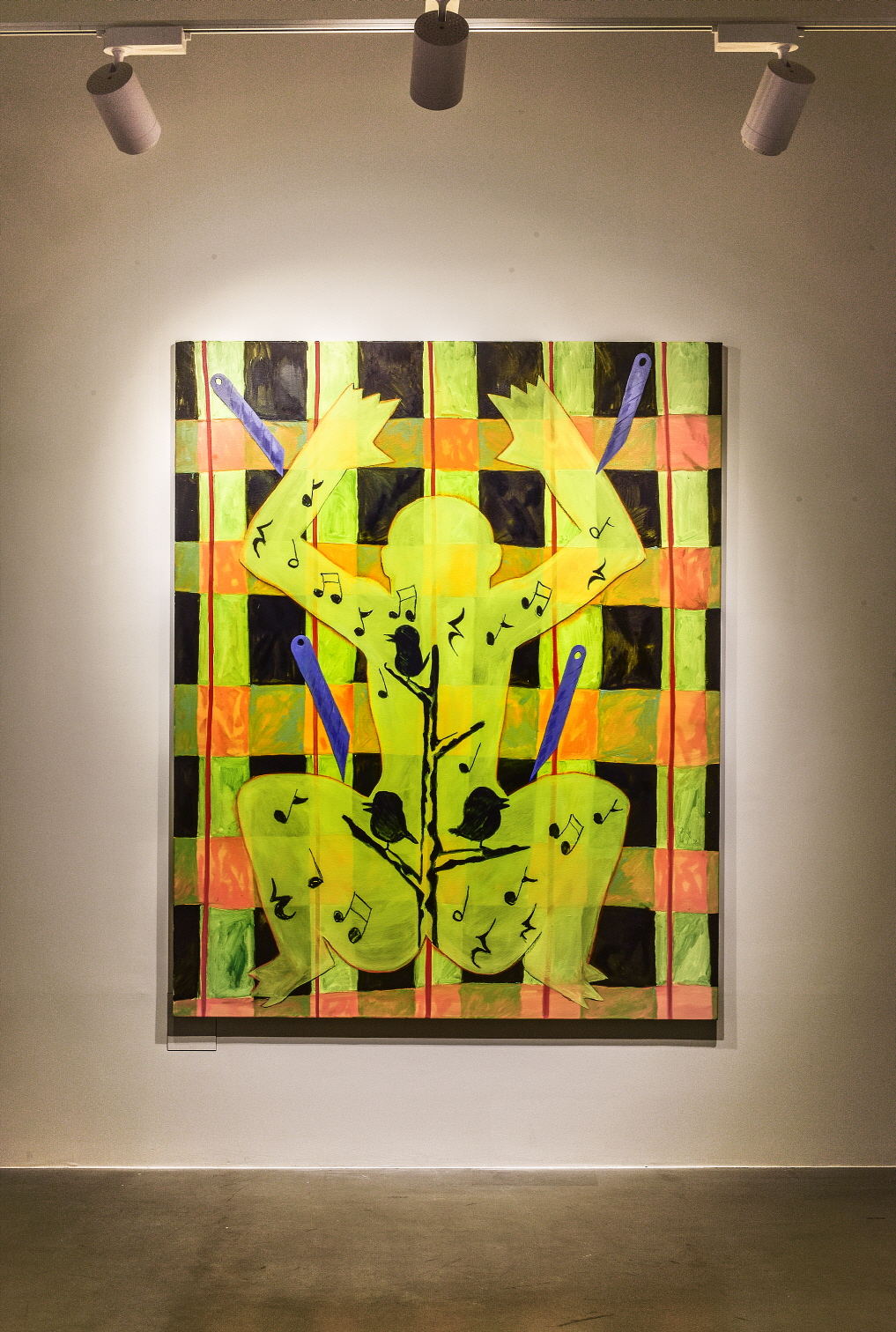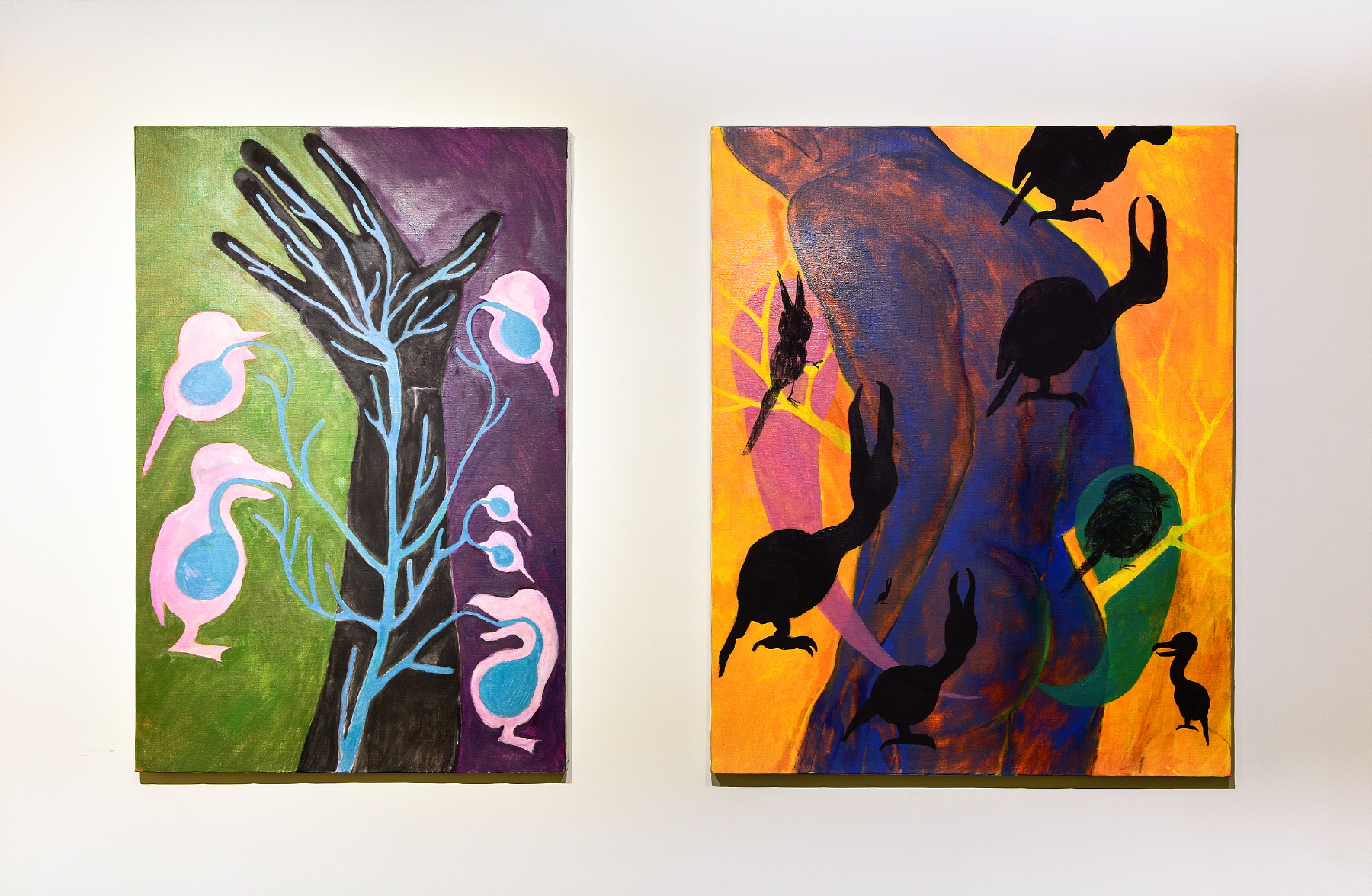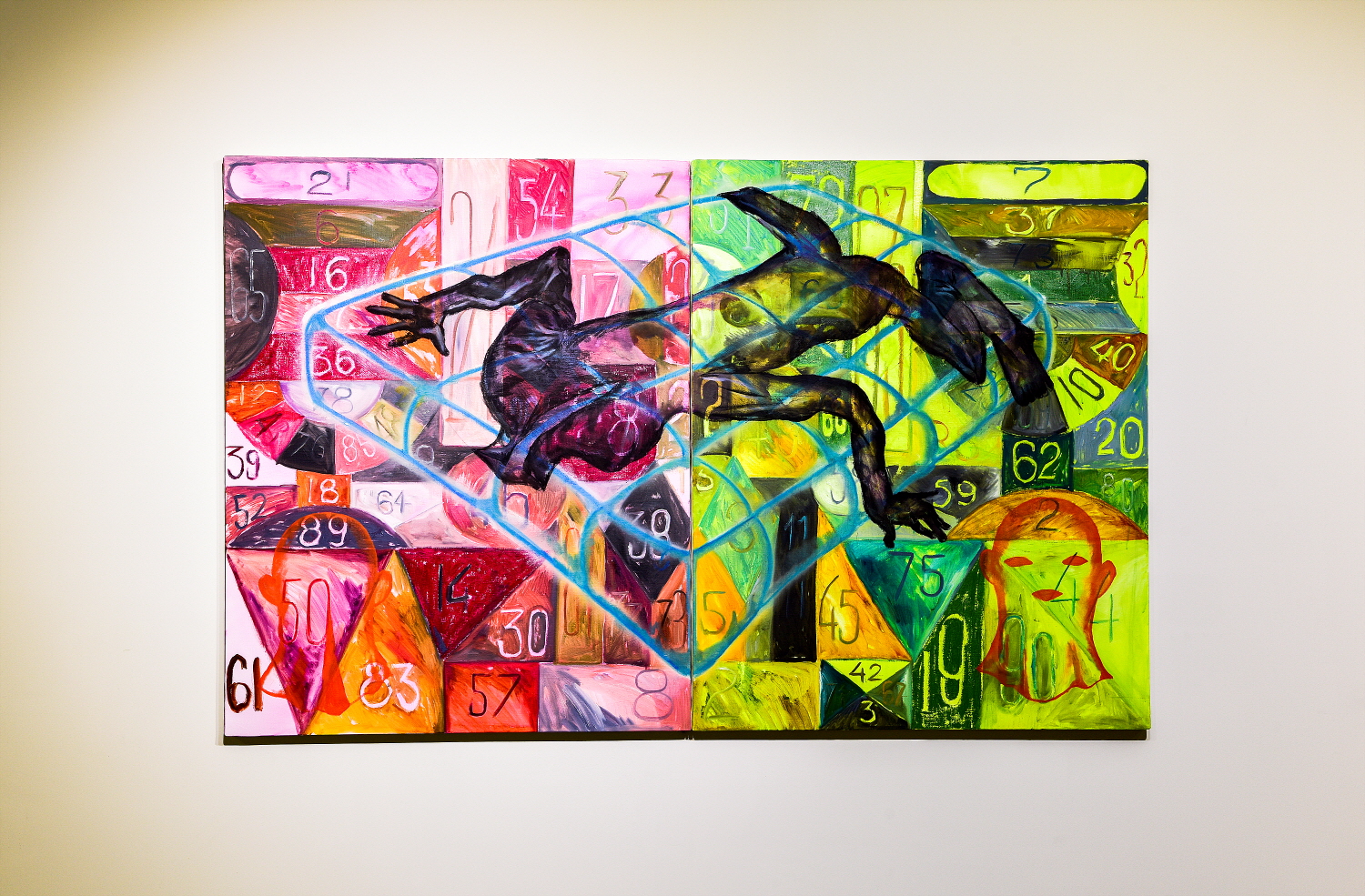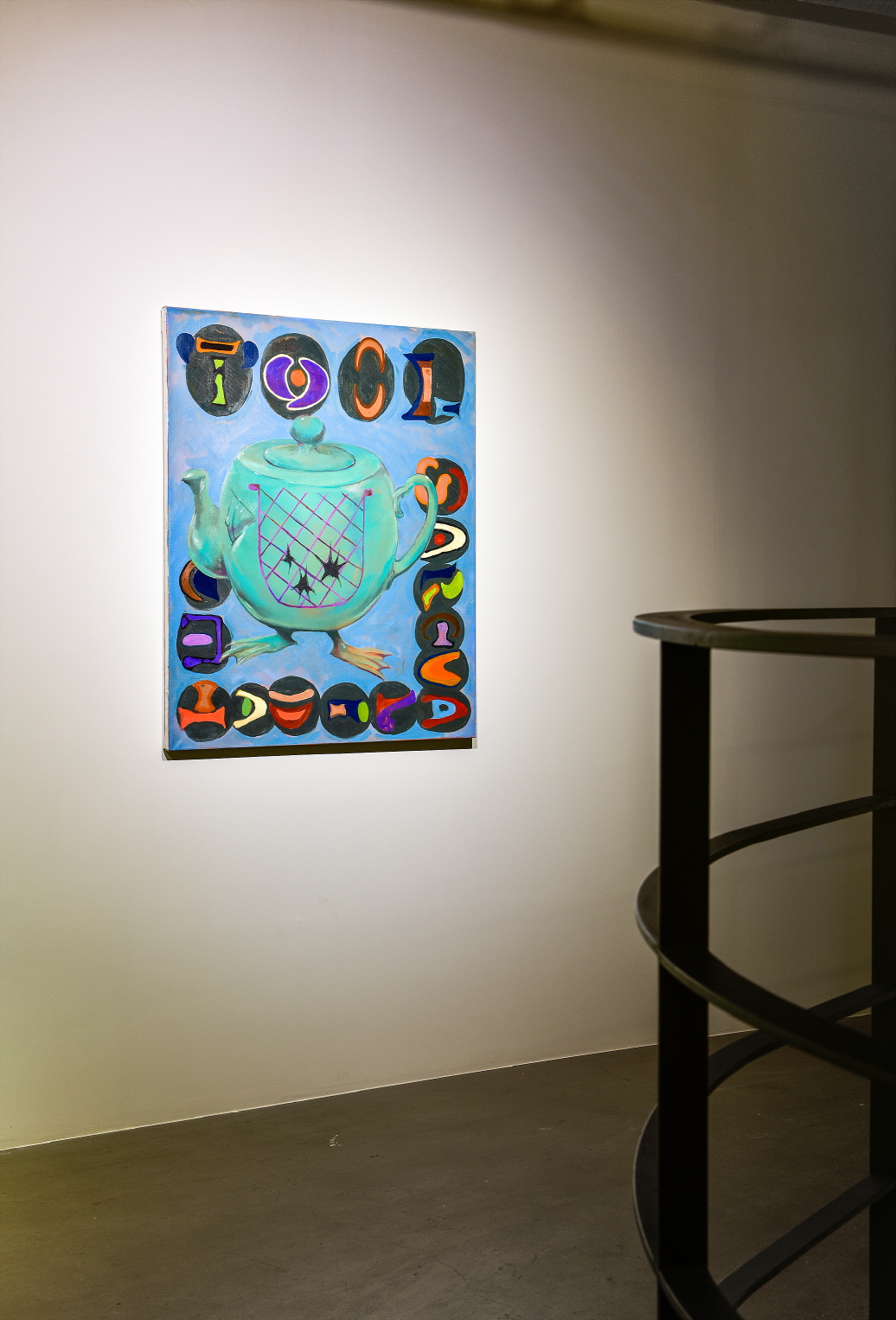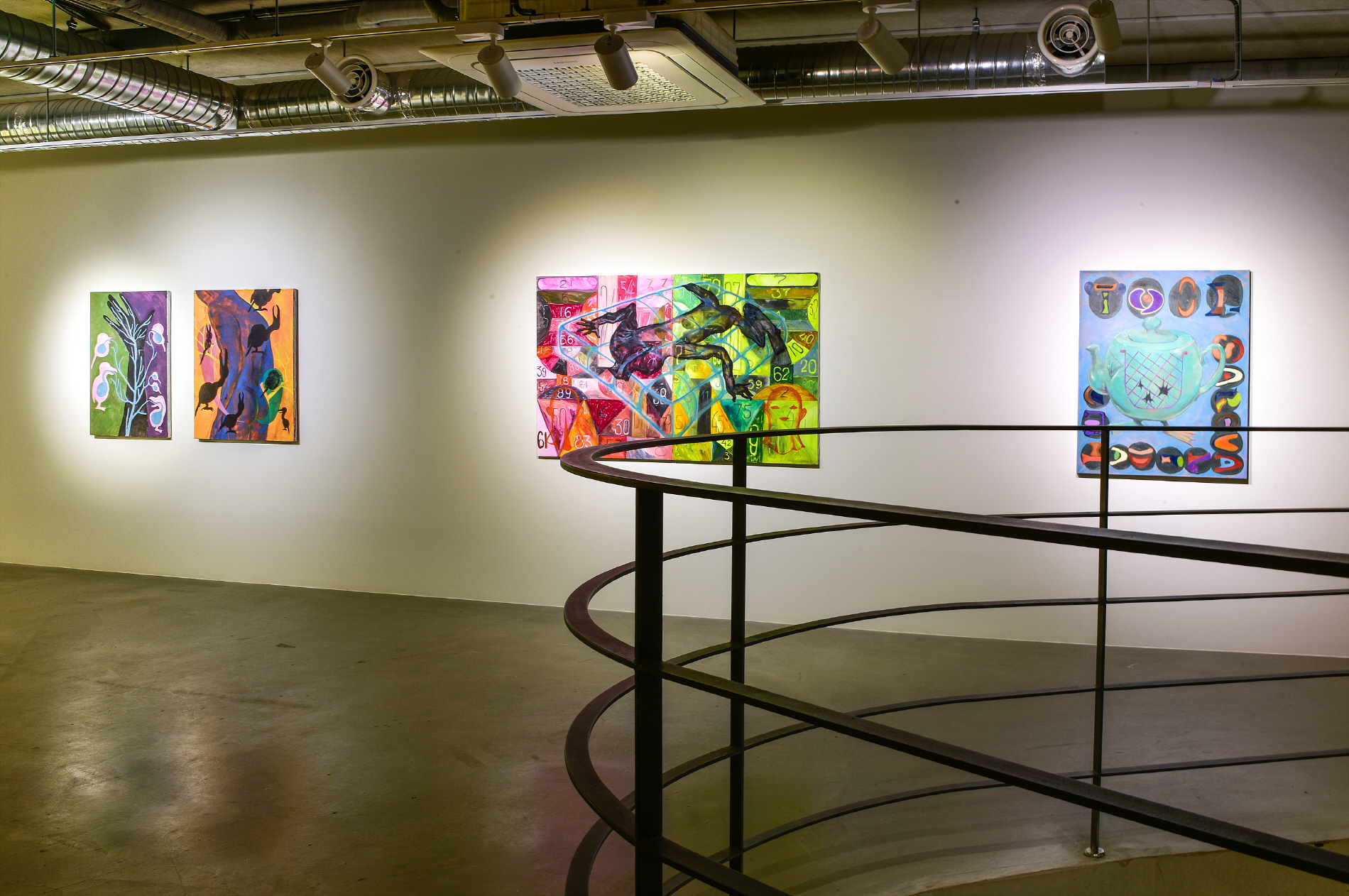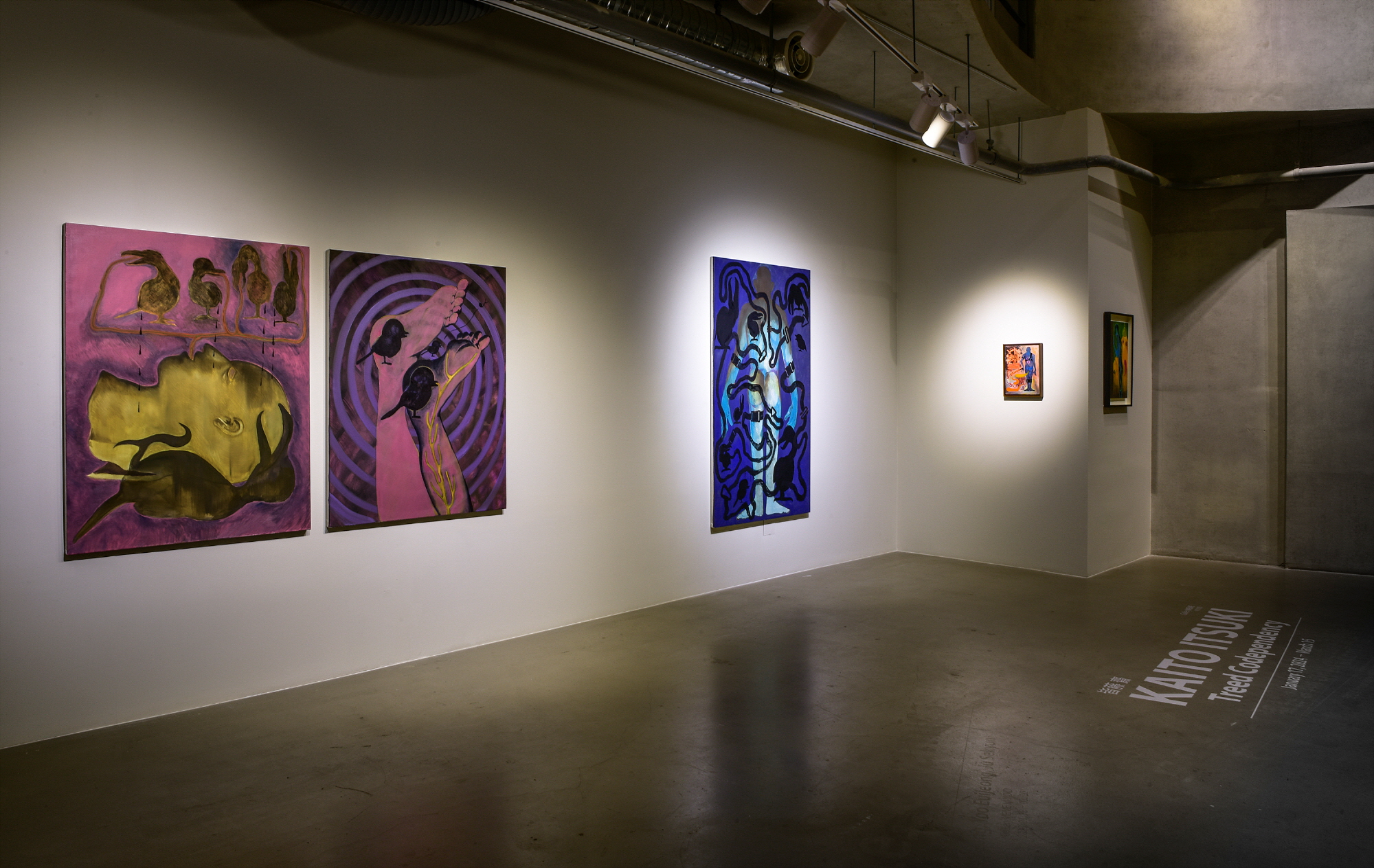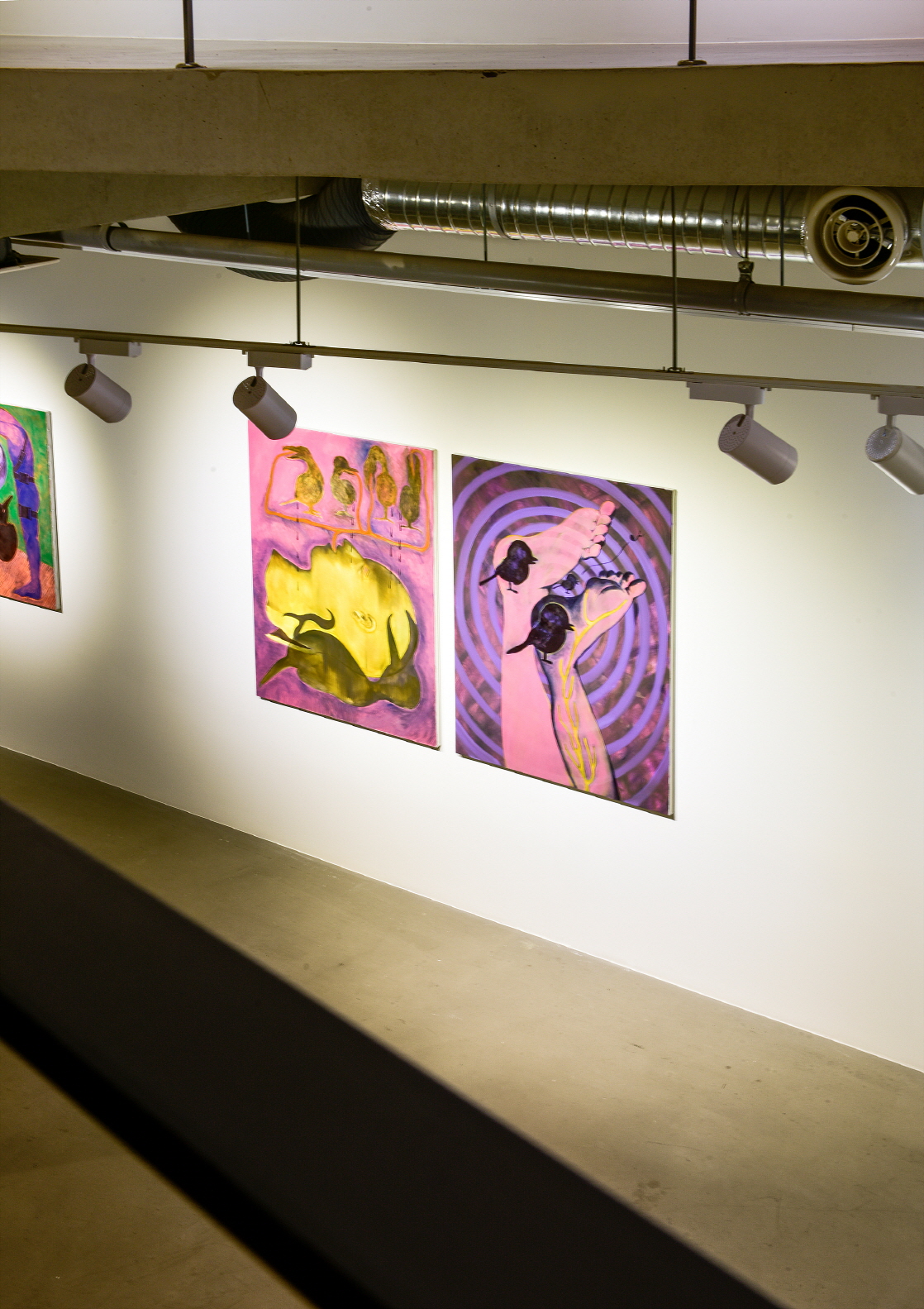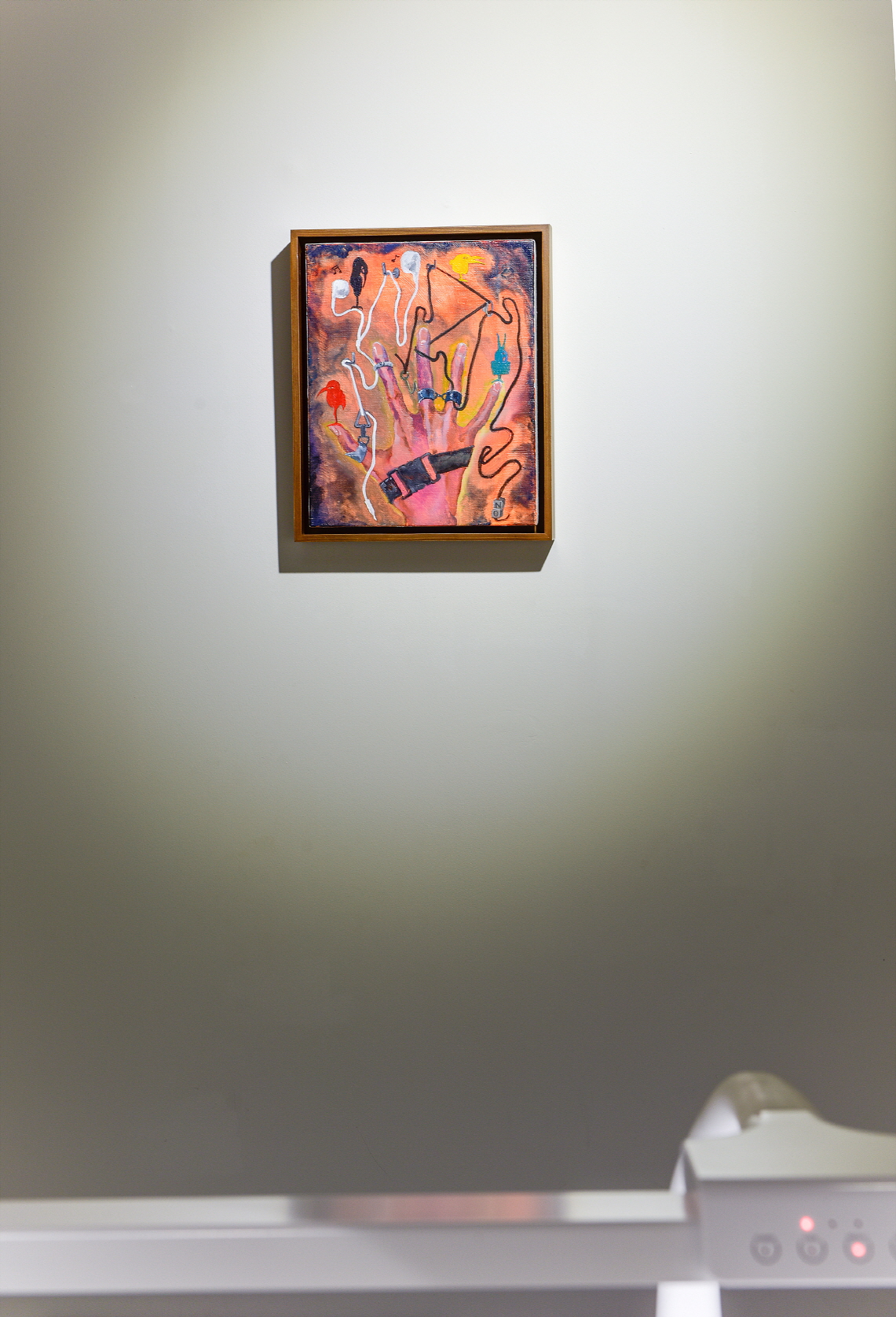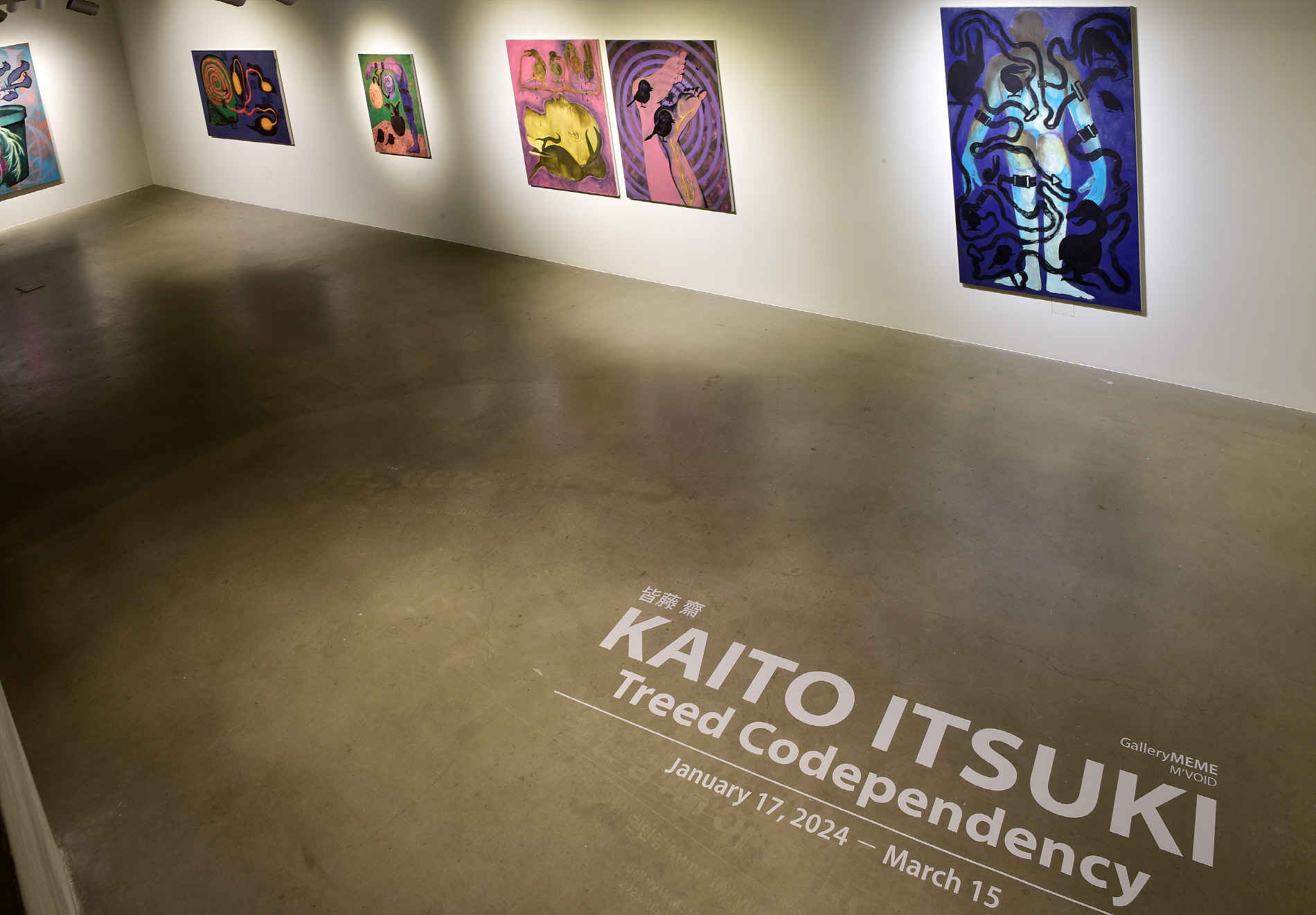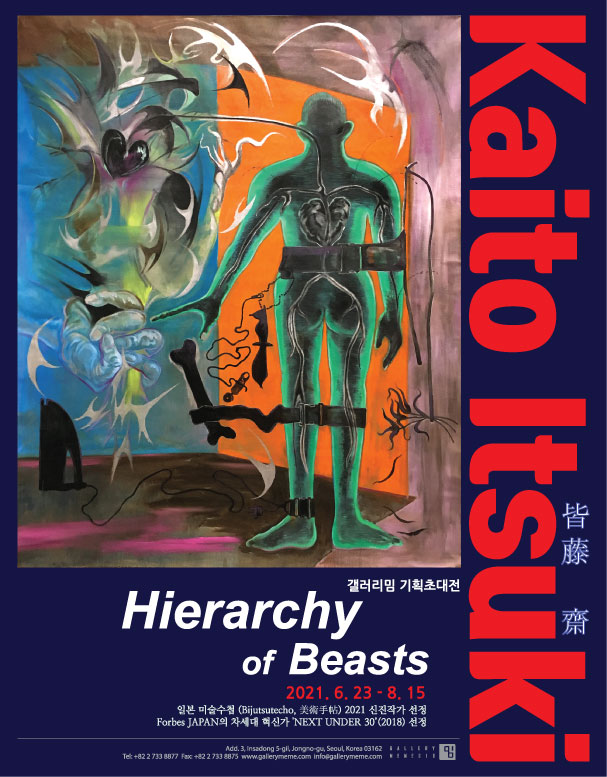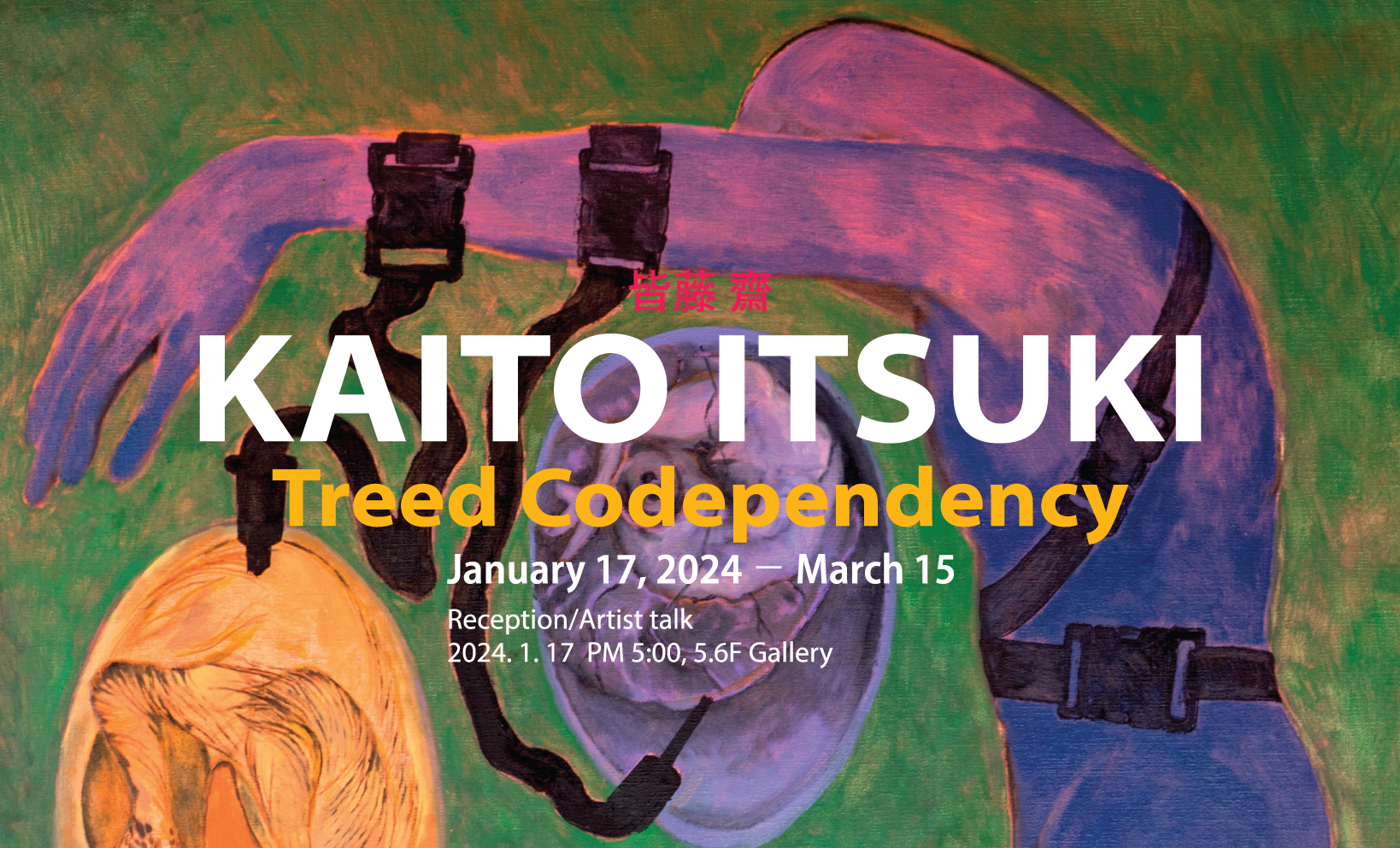
Treed Codependency
Kaito Itsuki
M’VOID is a program that plans and presents exhibitions of leading artists at home and abroad who question contemporary aesthetic values while strengthening their works with insights.
ABOUT
전시 서문
Treed Codependency
이 젊은 작가의 영토는 한껏 넓어졌다. 수치심, 가면, 불쾌, 혼종의 도상들이 수수께끼 같은 은유들과 뒤섞이며 만들어내는 불협화음도 더 강렬해졌다. 그래서 더 매혹적이다. 2021년 갤러리밈에서의 전시 이후 뉴욕과 런던, 방콕, 베이징, 홍콩, 취리히 등으로 이어진 개인전은 쉽게 가질 수 없는 기회였다고 작가는 말한다. 여성의, 30대의, 일본작가의 정체성으로서 그렇다는 것이다.
카이토 이츠키(皆藤 齋 Kaito Itsuki)는 애초부터 자신에 대한 그와 같은 분류에 별다른 의미를 두지 않았던 것처럼, 무의식적으로 드러날 수밖에 없는 그런 요소들을 의도적으로 배제하려 하지도 않는다. 중국이나 유럽 콜렉터들이 그의 작품을 일본스럽다고 여기는 지점과 자국 관객들의 전혀 일본작가 같지 않다는 반응 모두 작가에겐 흥미로운 탐구 대상이다. 국경을 넘나들며 언어가 아닌 문화의 다양성으로 소통하는 미술현장에서의 체험은 이 젊은 작가가 스스로의 경계를 확장해 가는 데 더없이 귀한 자양분이 될 터이다.
한국에서 두번째로 선보이는 개인전 ‘Treed Codependency’는 단골 소재인 얼굴 없는 남자부터 인간의 몸을 공유하는 새, 숫자와 도형, 칼날과 포박용 도구들, 가면, 배설물에 이르기까지 생경스러운 조합의 수상한 풍경을 펼쳐낸다. ‘공의존’ (codependency)은 타인과의 불균형적인 관계맺기가 초래한 자아의 부재로 인해 서로에게 역기능적으로 의존하게 되는 관계를 이르는 심리학 용어다. 실제로 관계의 근본이 되는 ‘공감’과 같은 심리적 현상은 대상과의 간극을 이어주는 역할을 하면서 동시에 자아를 억압하는 기제로 작용하기도 한다.
제목이 함의하는 맥락을 작품 속에서 찾아내는 일은 쉽지 않다. 화면 속 이미지들은 의미 없이 그저 충돌하거나 접점 없는 개별적 존재로 보일 뿐이기 때문이다. 그러나 작가는 인간과 동물, 사물들을 독특한 방식으로 모으고 흩어내면서 기묘하고 때로는 불온해 보이는 환상의 세계를 거침없이 직조해낸다. 작가의 내러티브 안에서 인간은 새와 함께 화분 속에 심겨져 뿌리를 내리고(‘Green Pot’), 새에게 기꺼이 피를 나누거나(‘Feeding from Vein’), 심지어는 신체 일부를 둥지로 내어주기도 한다(Feeding Birds). 이쯤이면 이제 새는, 너이거나 혹은 내가 된다. 그리고 ‘관계’라는 것에 따라오게 마련인 압박과 순응의 무게를 가늠해 보는 순간을 마주하게 되기도 할 것이다. 작가는 어리석음과 교훈이 절묘하게 뒤섞인 우화와 같은 형식을 빌어 타존재의 수용과 자아의 영역 사이의 균형에 대한 이야기를 들려준다. 실제로 반려동물로 새를 키우고 있는 작가는 대상의 속성을 자신에게 투영시키는 방식으로 자아 표현에 대한 탐구를 이어간다고 말한다.
지난 전시에 이어 거듭 등장하는 인간의 배설물은 작가의 작품세계를 드러내는 강력한 기호로 자리잡은 듯 보인다. 귀여운 형태와 칼라로 변형된 이 도상은 수치심과 원초적 자아의 상징이다. 작가는 불쾌하고 쓸모없고 수치스러운 이 금기를 세상 밖으로 끄집어내기 위해 신화의 스토리텔링을 가져온다. 코코넛 꽃에서 탄생한 여신이 자신의 배설물로 마법의 힘을 지닌 소중한 식량을 키워낸다는 인도네시아 신화 속 여신의 이야기가 그것이다. 작가가 이전에 다루었던 그리스 신화의 아마조네스에 이은 또다른 여신의 존재로, 아마조네스가 남성이라는 권력의 주체를 배제하는 방식으로 유토피아를 꿈꾸었다면, 이 여신은 순환하는 대자연의 생명력으로 세상을 품고 키워낸다. 신화를 통해 금기의 대상은 고귀한 존재로 전환된다. 작가는 때로는 당혹스럽고 이해할 수 없는 인간의 심리와 행동을 들여다보기 위해 신화나 고대서사를 은유의 렌즈로 사용하며 금기를 넘어서는 신기루를 제시한다. 그 신기루 속 환영들은 대담한 칼라의 극명한 대비로 불안감과 생생함이 공존하는 강렬한 에너지를 뿜어낸다.
이 재능 넘치는 젊은 작가가 세상을 향해 내미는 자신의 신화는 여전히 낯설고 때로는 불편하다. 그럼에도 저항없이 작가의 내러티브 안으로 흡수되도록 이끌어지는 것은, 다른 존재로 연결되고자 하는 욕망과 자율성에 대한 욕구는 누구에게나 유효하기 때문이다. 그리고 때때로 설명할 수 없는 인간의 잉여적 행위나 이질적인 행위들을 그대로 받아들이는 것이 우리의 마음과 몸 사이의 복잡한 상호작용을 제대로 들여다보고 균형점을 찾아가는 방식이 아니겠냐는 제안 또한 그러하다.
수많은 역경 끝에 참된 자아를 찾아가는 여느 신화의 본질처럼, 카이토 이츠키가 도달하고자 하는 곳 역시 자신만의 정체성의 체계를 세우고 자아를 확장시켜 나갈 수 있는 내면의 영토일 것이다. 불순함이 순수함을 단련시키고, 생경함이 더 자연스럽고, 불완전성이 도리어 신비가 되는 카이토 이츠키의 역설의 신화가 그 영토 안에서 단단하게 뿌리내리고 무성한 잎을 피워낼 것임을 감히 확신해 본다.
김현진 (갤러리밈 전시기획자)
작가와의 서면 인터뷰 중
작품의 주요 포인트는?
- 상반되는 요소들이 키메라(chimera)처럼 결합되는 지점이다. ‘귀여운/무서운’, ‘밝은/어두운’, ‘추상적/설명적’과 같이 대비되는 요소들을 다양하게 포함시키려고 한다. 언어도 문화도 다른 해외 관객들은 그 가운데서 각기 다른 끌림의 포인트들을 찾아내는 것 같다. 그 점이 흥미롭다.
작품 속 내러티브를 만들어가는 과정은?
- 컨셉을 정하면 모티프들이 끝말잇기처럼 연결되며 떠오른다. 주제에 따른 제한은 있지만, 그 제한 때문에 시너지가 증폭되는 이미지를 잡아낼 수 있다. 폭력적 이미지나 불편한 소재들을 두려움 없이 표현할 수 있는 것은, 각각의 이미지에 부여되는 개별적 의미보다는 끝말잇기처럼 이어지며 발생하는 대비나 은유가 상상의 경계를 더욱 확장시켜주기 때문이다.
작품을 통해 들려주고 싶은 이야기는?
- 지속적으로 다루고 있는 주제 중 하나는 ‘비생산적이고 불필요한 것을 받아들이는 것’이다. 나는 이것을 사람의 배설물 이미지로 표현한다. 쓸모없고 혐오스럽고 불쾌하지만, 부정할 수 없는 우리 정체성의 한부분이다. 사회의 암묵적 규범이나 억압적 금기를 넘어서는 과정들이 우리를 단순한 존재에서 사유하는 인간으로, 그리고 예술의 세계로 이끈다고 생각한다.
Treed Codependency
This
young artist’s territory has been expanded. The cacophony of the icons of
shame, fake, displeasure, and hybrid, mixed with enigmatic metaphors, has
become more intense as well. But such is the appeal of her works. The artist
refers to her solo exhibitions in New York, London, Bangkok, Beijing, Hong
Kong, and Zurich, following her last exhibition at GalleryMEME in 2021, as a
lifetime opportunity. She means this as a ‘female’ ‘Japanese’ artist ‘in her
30s’.
Kaito
Itsuki (皆藤 齋) does
not bother intentionally excluding the elements of the unconscious as much as
she neglects the social and cultural significance of the categories of her
identity. The point at which the Chinese and European collectors find her works
to be quintessentially Japanese and the response from her local audience that
she is ‘un-Japanese’ are all interesting subjects for the artist. Her
experiences in the art scene, in which the artists communicate with cultural
diversity rather than language, should be a precious catalyst for the
consistent pushing of the artistic boundaries for this young artist.
Her
second exhibition in Korea, Treed
Codependency, unravels a peculiar scenery that combines unfamiliar and
defamiliarized objects and icons ranging from her famous faceless men, birds
that share human bodies, numbers and icons, blades and bondage tools to
excretion. ‘Codependency’ in the title refers to a term in psychology that
denotes a relationship in which an absence of the ego caused by the imbalanced
relationship leads to a dysfunctional dependency on one another. A
psychological phenomenon that lays a foundation for relationships, such as
‘empathy’, not only serves the purpose of bridging the gap between the agent
and the object but concurrently functions as a mechanism that suppresses the
Ego.
Locating
within the works a context that the title implies is not an easy errand, for
the images on the canvas may only appear as mere collisions or independent
entities without meaning. The artist, however, inexorably weaves a fantastical
world that is peculiar and, at times, disquieting, by collecting and dispersing
figures, animals, and objects in a uniquely meaningful manner. In her
narratives, humans take roots in the pot planted with birds (Green Pot), share their blood with birds
(Feeding from Vein), or even let
birds use parts of their bodies as nests (Feeding
Birds). Birds, at this point, become either Other or Oneself. Such
anthropomorphized birds will even face the moment where they must face the
anguish of weighing pressure and conformity that follow relationships. The
artist uses a fable-like form that skillfully mixes idiocy and morale to tell a
narrative of the balance between the acceptance of Others and the domain of the
Ego. Living with a bird, the artist tells us that her exploration of the
self-expression of the Ego persists in a way where her close observation of the
properties of the objects is projected onto herself.
Human
excretion, which is a continued legacy from the last exhibition, seems to have
become a powerful symbol that reveals her artistic worldbuilding. The icon,
transformed into adorable forms and cute colors, is a symbol of shame and the id.
The artist brings the archetypal narratives of the myth to bring out the taboo
of displeasure onto this world. Such is the case of the coconut-born goddess
from the Indonesian myth who nurtures and cultivates magical food with her
excretion. It is another goddess symbol following the Amazons from the Greek
mythology that the artist previously described. If the Amazons dreamed of a
utopia based on the exclusion of the agent of power that is men, the
coconut-born goddess embraces the world and nurtures it with the circulatory
vitality of mother nature. Through myths, an object of taboo transitions into a
precious object. As such, the artist employs myths or archetypal narratives as
a metaphorical prism to offer a mirage that moves beyond the totems and taboos
so as to delve deeper into the psychology and behavior of humankind that are
often perplexing and inexplicable. The illusions in the mirage emanate a
powerful energy in which anxiety and vividness coexist in the sharp and
conspicuous contrast of bold colors.
The myth
that this talented young artist offers the world is still unfamiliar, and,
oftentimes, uncomfortable. Nonetheless, that which uncompromisingly leads us to
a total immersion into her narrative is the valid, universal desire to be
connected to other forms of existence and the desire for autonomy. Her
suggestion, that to accept the often inexplicable gratuity and peculiarity of
human behavior as is is the right way to look into the intricate interplay
between the mind and the body and find a balance between them, is in such a
line of logic.
Much
like the essence of myths where the odyssey to one’s true ego is prevalent,
Kaito Itsuki, too, takes her journey through many trials and tribulations to an
innermost territory where she can finally establish her own sense of identity
and expand her Ego. It is axiomatic that Itsuki’s myths of paradox, where
impurity trains purity, unfamiliarity becomes familiar, and imperfection
evolves into mysticism, will take root and bloom infinitely in such a
territory.
Kim Hyunjin (Curator,
GalleryMEME)
From
the Interview
What is the main focal point of the artworks?
- It is where diametrically opposed elements combine like a chimera. I try to include various binary opposites such as ‘cute/scary’, ‘bright/dark’, or ‘abstract/descriptive’ into my works. I found that the audience from different cultural and sociolinguistic backgrounds find their own appeals amidst such combinations of binary opposites. It is fascinating to me.
How
do you form the narratives in your artwork?
- Once I come up with a bigger picture, or a concept, motifs, quite naturally and concomitantly, follow. While there are limitations as to the themes, it is precisely such a limitation that lets me capture the images with which the synergy of the theme and the motifs is maximized. Part of the reason why I am able to describe violent images or uncomfortable elements is that the train of contrasts and metaphors from my otherwise independently uncomfortable images are more conducive to expanding the boundary of imagination. That is to say, the detriment of the violent and uncomfortable meanings of each image does not outweigh the stimulation of the imagination that the complete image brings about.
What
do you intend to tell with your artwork?
- One of the recurrent and consistent themes is ‘the acceptance of unproductive and gratuitous things’. I express this through the images of human excretion. It is useless, repulsive, and displeasing, but an indispensable part of human existence and identity. I believe that the process through which we transgress the social agreements, regulations, or stifling taboos will transform us from a mere existence to a thinker, and eventually lead us into the world of art.
Kaito Itsuki
2019 Kyoto city university of arts (KCUA), Painting Department, Kyoto, Japan (MFA)
2016 Tōhoku University of Art &
Design (TUAD), Fine arts Department, Yamagata, Japan (BFA)
SOLO Exhibition
2024 Treed Codependency, GalleryMEME, Seoul
2023 Looming digits, Blue
velvet, Zürich
The Elastic Edges, Ritsuki Fujisaki, Tokyo
2022 The Monopolistic Sweet Spots, MAMOTH, London
Tools are validated, Tang Contemporary Art, Bangkok
黩 Blacken, HIVE
CENTER FOR CONTEMPORARY ART, Beijing
被制限的行動、心理電影, HUA ART SPACE, Beijing
2021 現れるのに勝手はない/ No excuses for
showing up, LEESAYA, Tokyo
Hierarchy of Beasts, GalleryMEME, Seoul
2020 In search of..., 14a,
Hamburg,Germany
2019 たりない循獣 / Unsatidfied animals of the
cycle, GINZA TSUTAYA, Tokyo
IDÉE FIXE, Tong Gallery + Project, Beijing
2018 Tiger Poet, CLEAR GALLERY,
Tokyo
2017 THE WOMEN FROM THE GROUND, DNA, N’s art project, Osaka
Jungle -7,000,000, MORI YU GALLERY, Kyoto
Tiger Technique, KCUA, Kyoto
GROUP Exhibition (selected)
2023 Fungal Fugue, HAGIWARA
PROJECTS, Tokyo
CARE PACKAGE, Blue Velvet
Project, Zürich
2022 The Tale of Tales, G
Museum 金鹰美术馆, Nanjing
Cope, No Gallery, New York, curated by Sven Loven
Temple, Seventh Gallery, Melbourne, curated by
Michael Kennedy
2021 Couple of, Hive contemporary
art center, Beijing
Slow Culture, @KCUA, Kyoto
Low Fever, Tang Contemporary Art, Hong Kong
2020 COLLECTION AS POEM IN THE AGE OF
EPHEMERALITY, X museum, Beijing
Y-generation artists, GINZA TSUTAYA ATRIUM, Tokyo
A Delinquent Child Having An Out Of Body Experience, THE
RESIDENCE GALLERY, London
2019 Complete Metamorphosis, SuperDutches, New York, US
Scaffolds of Meaning / 懶音, MINE
PROJECT, Hong Kong
Feelings for a spider, 4646, Tokyo, Japan
Amazondom, Pulp, Osaka, Japan
KUMA EXHIBITION 2019, Spiral, Tokyo, Japan
2018 Encounters, PDX CONTEMPORARY
ARTS, Portland, Oregon, US
KUMA EXHIBITION, Spiral, Tokyo, Japan
KAISEI, Pehu, Osaka, Japan, Galerie P38, Paris, France, KG, Tokyo, Japan
2017 The 4th CAF prize exhibition, Hillside terrace, Tokyo, Japan
Collections
Star Museum (Shanghai), He art museum (Guangdong), X museum (Beijing), Tōhoku University of Art & Design (Yamagata)
Artist program
2017 Feldstärke
International, Hunan University, China, Daegu Art
Factory, Korea, Kyoto Art Center, Japan
2016 End of summer, Yale
union Contemporary art center, Portland, US
Others
2022 Art News Japan 30 artists
nominated
2021 "30 artist Under 35" by
ARTnews Japan nominated
KUMA Foundation grant recipient
2020 The Peter S. Reed Foundation grant
recipient
2018 ARTIST’S FAIR KYOTO, Kyoto, Japan
KUMA Foundation scholarship student

